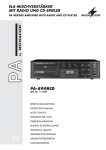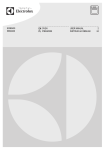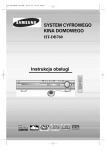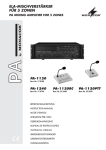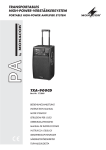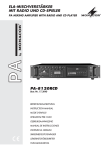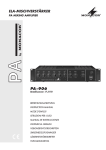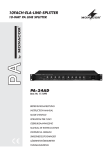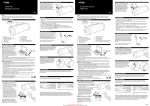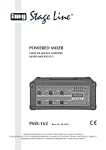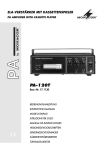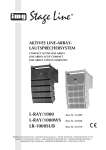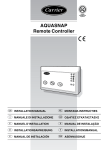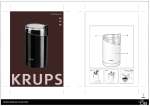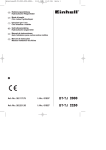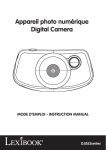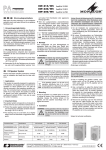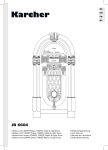Download PA-802CD ELA-MISCHVERSTÄRKER MIT CD-SPIELER
Transcript
ELA-MISCHVERSTÄRKER MIT CD-SPIELER PA AMPLIFIER WITH CD PLAYER PA-802CD Best.-Nr. 17.3020 BEDIENUNGSANLEITUNG INSTRUCTION MANUAL MODE D’EMPLOI ISTRUZIONI PER L’USO GEBRUIKSAANWIJZING MANUAL DE INSTRUCCIONES INSTRUKCJA OBSŁUGI SIKKERHEDSOPLYSNINGER SÄKERHETSFÖRESKRIFTER TURVALLISUUDESTA D A CH F B CH Bevor Sie einschalten … GB Before switching on … Wir wünschen Ihnen viel Spaß mit Ihrem neuen Gerät von MONACOR. Bitte lesen Sie diese Bedienungsanleitung vor dem Betrieb gründlich durch. Nur so lernen Sie alle Funktionsmöglichkeiten kennen, vermeiden Fehlbedienungen und schützen sich und Ihr Gerät vor eventuellen Schäden durch unsachgemäßen Gebrauch. Heben Sie die Anleitung für ein späteres Nachlesen auf. We wish you much pleasure with your new MONACOR unit. Please read these operating instructions carefully prior to operating the unit. Thus, you will get to know all functions of the unit, operating errors will be prevented, and yourself and the unit will be protected against any damage caused by improper use. Please keep the operating instructions for later use. Der deutsche Text beginnt auf der Seite 4. The English text starts on page 8. Avant toute installation … I Nous vous souhaitons beaucoup de plaisir à utiliser cet appareil MONACOR. Lisez ce mode dʼemploi entièrement avant toute utilisation. Uniquement ainsi, vous pourrez apprendre lʼensemble des possibilités de fonctionnement de lʼappareil, éviter toute manipulation erronée et vous protéger, ainsi que lʼappareil, de dommages éventuels engendrés par une utilisation inadaptée. Conservez la notice pour pouvoir vous y reporter ultérieurement. Prima di accendere … Vi auguriamo buon divertimento con il vostro nuovo apparecchio di MONACOR. Leggete attentamente le istruzioni prima di mettere in funzione lʼapparecchio. Solo così potete conoscere tutte le funzionalità, evitare comandi sbagliati e proteggere voi stessi e lʼapparecchio da eventuali danni in seguito ad un uso improprio. Conservate le istruzioni per poterle consultare anche in futuro. Il testo italiano inizia a pagina 16. La version française se trouve page 12. NL B Voor u inschakelt … E Wij wensen u veel plezier met uw nieuwe apparaat van MONACOR. Lees deze gebruikershandleiding grondig door, alvorens het apparaat in gebruik te nemen. Alleen zo leert u alle functies kennen, vermijdt u foutieve bediening en behoedt u zichzelf en het apparaat voor eventuele schade door ondeskundig gebruik. Bewaar de handleiding voor latere raadpleging. Antes de la utilización … Le deseamos una buena utilización para su nuevo aparato MONACOR. Por favor, lea estas instrucciones de uso atentamente antes de hacer funcionar el aparato. De esta manera conocerá todas las funciones de la unidad, se prevendrán errores de operación, usted y el aparato estarán protegidos en contra de todo daño causado por un uso inadecuado. Por favor, guarde las instrucciones para una futura utilización. De Nederlandstalige tekst vindt u op pagina 20. La versión española comienza en la página 24. PL Przed uruchomieniem … DK Życzymy zadowolenia z nowego produktu MONACOR. Dzięki tej instrukcji obsługi będą państwo w stanie poznać wszystkie funkcje tego urządzenia. Stosując się do instrukcji unikną państwo błędów i ewentualnego uszkodzenia urządzenia na skutek nieprawidłowego użytkowania. Prosimy zachować instrukcję. Før du tænder … Tillykke med dit nye MONACOR produkt. Læs sikkerhedsanvisningerne nøje før ibrugtagning, for at beskytte Dem og enheden mod skader, der skyldes forkert brug. Gem manualen til senere brug. Sikkerhedsanvisningerne findes på side 32. Tekst polski zaczyna się na stronie 28. S Innan du slår på enheten … Vi önskar dig mycket glädje med din nya MONACOR produkt. Läs igenom säkerhetsföreskrifterna innan enheten tas i bruk för att undvika skador till följd av felaktig hantering. Behåll instruktionerna för framtida bruk. Säkerhetsföreskrifterna återfinns på sidan 32. FIN Ennen kytkemistä … Toivomme Sinulle paljon miellyttäviä hetkiä uuden MONACOR laitteen kanssa. Ennen laitteen käyttöä pyydämme Sinua huolellisesti tutustumaan turvallisuusohjeisiin. Näin vältyt vahingoilta, joita virheellinen laitteen käyttö saattaa aiheuttaa. Ole hyvä ja säilytä käyttöohjeet myöhempää tarvetta varten. Turvallisuusohjeet löytyvät sivulta 33. 2 1 PA-802CD AMPLIFIER OFF CHIME SIREN 0 POWER 10 0 MIC1 10 0 MIC 2 10 CD LINE CD/USB 1 2 3 4 5 6 7 8 a 2 9 10 11 12 13 14 b c 16 d REP ALL RAN e 15 CD f g h i 3 12V COM DC POWER T6.3AL 25V 70V 100V T800mAL FU SE ON FUSE OFF DC FUSE T6.3A 250 V AC FUSE T800 mA 250 V 230V~/50 Hz GND 17 19 4b 100V 12V COM 25V 70V 100V 20 COM 25V 70V 100V + + 25V 70V 100V + max. Belastung max. load 15 W RMS 70V + + 25 V - ..... ..... 70V - + + 25 V - 4Ω 4e 12V COM 4f 25V 70V 100V + + ³4½ ³4½ - 25V 70V 100V + ³4½ - 4Ω 12V + ³8½ - + ³4½ - COM ³4½ - + 4g 4Ω 12V max. Belastung max. load 15 W RMS 25 V - 70V - + 3 COM + 25V 70V 100V - 25V 12V 100V - 4Ω COM 23 + max. Belastung max. load 15 W RMS 100V - 12V 22 4c 70 V 12V 100V - 4d 21 ..... 4a 18 COM 25V 70V 100V + ³8½ - + ³16 ½ - + ³16 ½ - + ³16 ½ - ³16 ½ - D A CH schneller Vor- / Rücklauf Für den Vorlauf die Taste für den Rücklauf die Taste Auf der ausklappbaren Seite 3 finden Sie alle beschriebenen Bedienelemente und Anschlüsse. 1 13 Taste für die Wiederholfunktionen und die Zufallswiedergabe Übersicht der Anschlüsse und Bedienelemente 1. Tastendruck: Anzeige REP endlose Wiederholung des momentanen Titels 1 Taste zum Einschalten des Gongs (linke Kante drücken, Taste rastet nicht ein) oder zum Einschalten der Sirene (rechte Kante drücken, Taste rastet ein) 2. Tastendruck: Anzeige REP ALL endlose Wiederholung aller Titel 2 Ein-/Ausschalter für den Netzbetrieb, mit Betriebsanzeige 3. Tastendruck: Anzeige RAN Wiedergabe der Titel in zufälliger Reihenfolge 3 Kanal MIC 1 mit Pegelregler und Eingangsbuchse zum Anschluss eines Mikrofons; bei einer ausreichend lauten Durchsage wird die Lautstärke der anderen Kanäle abgesenkt 4. Tastendruck: Anzeige RAN erlischt Extrafunktionen ausgeschaltet 4 Kanal MIC 2 mit Pegelregler und Eingangsbuchse zum Anschluss eines Mikrofons 5 Kanal LINE mit Pegelregler und Mono-Eingangsbuchse zum Anschluss eines Audiogerätes (Mischpult, MP3-Player, Tuner etc.) 6 CD-Schublade, lässt sich mit der Taste nen und schließen (16) öff- 14 Tasten und CD-Spielers 8 Display des CD-Spielers a REP wird bei eingeschalteter Wiederholfunktion angezeigt b Wiedergabesymbol c Pausensymbol d CD wird angezeigt, wenn eine Standard-AudioCD (CD-DA = compact disc digital audio) eingelegt ist e ALL wird zusätzlich zu REP (a) angezeigt, wenn alle Titel endlos wiederholt werden f RAN wird angezeigt, wenn die Titel in zufälliger Reihenfolge abgespielt werden g Nummer des angewählten Titels oder, mit dem Buchstaben F davor, Nummer des Ordners (z. B. F04) h bereits gespielte Zeit des Titels i Anzeige des Anti-Schock-Speichers Kap. 5.2.4) ( 9 Taste zur Einstellung der Lautstärke des 15 Ein- /Ausschalter für den CD-Spieler Nach dem Betätigen der Taste min. 3 Sek. warten, bevor sie erneut gedrückt wird. 16 Taste zum Öffnen und Schließen der CD-Schublade (6) 17 Schutzabdeckung für die Anschlussklemmen WARNUNG Den Verstärker nie ohne die Abdeckung betreiben. Anderenfalls besteht bei Berührung der Anschlüsse die Gefahr eines elektrischen Schlages. 7 USB-Schnittstelle zum Einstecken eines USBSticks oder zum Anschluss einer Festplatte 18 Anschlussklemmen 12 V für den Betrieb mit 12 V oder für eine 12-V-Notstromversorgung 19 Anschlussklemmen für die Lautsprecher: 100-V-, 70-V- oder 25-V-Lautsprecher oder Niederohmlautsprecher (minimale Anschlussimpedanz 4 Ω) 20 Masseanschluss, kann z. B. bei Brummproblemen verwendet werden 21 Ein-/Ausschalter DC POWER für den Betrieb mit 12 V oder für eine 12-V-Notstromversorgung 22 Halterungen für die Sicherungen Eine geschmolzene Sicherung nur durch eine gleichen Typs ersetzen. 23 Netzkabel zum Anschluss an eine Steckdose (230 V~ / 50 Hz) zum Beenden des Abspielens 10 Taste zum Umschalten zwischen Wiedergabe und Pause 11 Taste CD / USB zum Umschalten zwischen CD und USB-Anschluss (7) 12 Tasten und zur Titelanwahl und für den schnellen Vor- und Rücklauf Titelanwahl Mit jedem Drücken der Taste wird ein Titel vorgesprungen; durch Drücken der Taste wird an den Titelanfang gesprungen und mit jedem weiteren Drücken ein Titel zurück. 4 gedrückt halten, . 2 Hinweise für den sicheren Gebrauch Das Gerät entspricht allen relevanten Richtlinien der EU und ist deshalb mit gekennzeichnet. WARNUNG Das Gerät wird mit lebensgefährlicher Netzspannung (230 V~) versorgt. Nehmen Sie deshalb niemals selbst Eingriffe am Gerät vor und stecken Sie nichts durch die Lüftungsöffnungen! Es besteht die Gefahr eines elektrischen Schlages. Beachten Sie auch unbedingt die folgenden Punkte: 4 G Den Verstärker so aufstellen, dass kein Wärmestau entstehen kann und die Lüftungsöffnungen nicht abgedeckt werden. Vor dem Anschließen bzw. vor dem Verändern von Anschlüssen den PA-802CD und die anzuschließenden Geräte ausschalten. Die Anschlüsse für die Lautsprecher und die 12-VVersorgung befinden sich unter der Schutzabdeckung (17). Zum Anschließen die Abdeckung abnehmen. Verwenden Sie das Gerät nur im Innenbereich und schützen Sie es vor Tropf- und Spritzwasser, hoher Luftfeuchtigkeit und Hitze (zulässiger Einsatztemperaturbereich 0 – 40 °C). G Stellen Sie keine mit Flüssigkeit gefüllten Gefäße, z. B. Trinkgläser, auf das Gerät. G Die in dem Gerät entstehende Wärme muss durch Luftzirkulation abgegeben werden. Decken Sie darum die Lüftungsöffnungen des Gehäuses nicht ab. G Nehmen Sie das Gerät nicht in Betrieb und ziehen Sie sofort den Netzstecker aus der Steckdose, 1. wenn sichtbare Schäden am Gerät oder an der Netzanschlussleitung vorhanden sind, 2. wenn nach einem Sturz oder Ähnlichem der Verdacht auf einen Defekt besteht, 3. wenn Funktionsstörungen auftreten. Geben Sie das Gerät in jedem Fall zur Reparatur in eine Fachwerkstatt. G Ein beschädigtes Netzkabel darf nur durch eine Fachwerkstatt ersetzt werden. G Ziehen Sie den Netzstecker nie am Kabel aus der Steckdose, fassen Sie immer am Stecker an. G Verwenden Sie für die Reinigung nur ein trockenes, weiches Tuch, niemals Wasser oder Chemikalien. G Wird das Gerät zweckentfremdet, nicht richtig angeschlossen, falsch bedient oder nicht fachgerecht repariert, kann keine Haftung für daraus resultierende Sach- oder Personenschäden und keine Garantie für das Gerät übernommen werden. Soll das Gerät endgültig aus dem Betrieb genommen werden, übergeben Sie es zur umweltgerechten Entsorgung einem örtlichen Recyclingbetrieb. 3 Verwendungsmöglichkeiten Dieser ELA-Verstärker ist für kleine Beschallungsanlagen geeignet. An seinem Ausgang können entweder ELA-Lautsprecher (100 V/ 70 V/ 25 V) oder Niederohmlautsprecher (Impedanz min. 4 Ω) verwendet werden. Er ist ausgestattet mit: Gerät aufstellen und anschließen WARNUNG D A CH Den Verstärker nie ohne die Abdeckung (17) betreiben. Anderenfalls besteht bei Berührung der Anschlüsse die Gefahr eines elektrischen Schlages. 1) Mikrofone können an die beiden Eingänge MIC 1 (3) und MIC 2 (4) angeschlossen werden. Der Eingang MIC 1 ist mit einer Vorrangschaltung (Talkover) ausgestattet. Wird laut genug in das Mikrofon gesprochen, verringert sich die Lautstärke aller anderen Eingangskanäle, sodass die Durchsage besser zu hören ist. 2) Ein Audiogerät mit Line-Pegel-Ausgang (Mischpult, MP3-Player, Tuner etc.) kann an die Mono-Buchse LINE (5) angeschlossen werden. Beim Anschluss eines Stereogerätes muss ein Stereo-Mono-Adapter verwendet werden, sonst wird der rechte Kanal nicht wiedergeben (z. B. SMC-1 von MONACOR). 3) An die Klemmen des Lautsprecherausgangs (19) entweder 100-V-, 70-V- oder 25-V-Lautsprecher anschließen (Abb. 4a, 4b und 4c) – der Verstärkerausgang darf mit maximal 15 W durch die Lautsprecher belastet werden, anderenfalls kann er beschädigt werden oder einen Lautsprecher oder eine Lautsprechergruppe mit einer Gesamtimpedanz von mindestens 4 Ω an die Klemmen „4 Ω“ und „COM“ anschließen. Die Abbildungen 4d bis 4g zeigen verschiedene Arten, die korrekte Impedanz zu erhalten. Es gibt aber noch weitere Möglichkeiten. Beim Anschluss der Lautsprecher immer auf die richtige Polarität achten, so wie es in den Abbildungen dargestellt ist. 2 × Mikrofoneingang, Kanal MIC 1 mit einer Vorrangschaltung zum automatischen Verringern der Lautstärke der anderen Kanäle 1 × Line-Pegel-Eingang zum Anschluss eines Audiogerätes 1 × CD-Spieler 1 × Taste für Gong und Alarmsirene 4) Zum Betrieb mit 12 V an die Klemmen 12 V (18) die 12-V-Spannungsquelle anschließen. An die Klemmen kann alternativ aber auch eine 12-V-Notstromversorgung angeschlossen werden. Bei einem Netzausfall arbeitet der Verstärker dann weiter. Der Betrieb des Verstärkers kann mit 230 V~ oder 12 V erfolgen. 5) Für den Netzbetrieb den Stecker des Netzkabels (23) in eine Steckdose (230 V~ / 50 Hz) stecken. 5 D 5 A Zur Vermeidung von Einschaltgeräuschen zuerst die angeschlossenen Geräte einschalten. Anschließend für den Netzbetrieb den Verstärker mit dem Netzschalter POWER (2) oder für den Betrieb mit 12 V mit dem Schalter DC POWER (21) einschalten. Ist eine 12-VNotstromversorgung angeschlossen, beide Schalter einschalten. Die grüne LED über dem Netzschalter POWER (2) leuchtet. CH Bedienung 5.1 Verstärkerteil 1) Soll vor einer Durchsage der Gong ertönen, die linke Kante der Taste CHIME – SIREN (1) drücken. Der Gong ertönt in maximaler Lautstärke. 2) Die Lautstärke für die Mikrofone mit den Reglern MIC 1 (3) und MIC 2 (4) einstellen. Wird laut genug in das Mikrofon MIC 1 gesprochen, verringert sich die Lautstärke aller anderen Eingangskanäle, sodass die Durchsage besser zu hören ist. 3) Ist ein Audiogerät an der Buchse LINE (5) angeschlossen, dessen Lautstärke mit dem Regler LINE einstellen. 4) Die Eingangssignale mit den Lautstärkereglern MIC 1, MIC 2, LINE und das Signal des CD-Spielers mit den Tasten und (14) mischen oder bei Bedarf ein- und ausblenden. Die Lautstärke der nichtbenutzten Kanäle stets auf Null stellen. 5) Zur akustischen Alarmierung lässt sich die Sirene mit dem Schalter CHIME – SIREN (1) einschalten. Dazu die rechte Kante der Wippe hineindrücken. Die Sirene ertönt in maximaler Lautstärke. Zum Ausschalten die linke Kante drücken. 6) Nach dem Betrieb den Verstärker vor allen anderen angeschlossenen Geräten zuerst ausschalten. 5.2 CD-Spieler Auf dem CD-Spieler können Standard-Audio-CDs abgespielt werden, auch selbst gebrannte (CD-R). Bei wiederbeschreibbaren CDs (CD-RW) kann es jedoch je nach CD-Typ, verwendetem CD-Brenner und Brennprogramm beim Abspielen zu Problemen kommen. Es lassen sich auch komprimierte Audiodateien (erstellt mit dem derzeit gängigsten Kompressionsverfahren) von CDs und über die USB-Schnittstelle (7) abspielen. 5.2.1 Hinweis zu Tonaussetzern und Lesefehlern Zigarettenrauch und Staub dringen leicht durch alle Öffnungen des Gerätes und setzen sich auch auf der Optik des Laser-Abtastsystems ab. Sollte dieser Belag zu Lesefehlern und Tonaussetzern führen, muss das Gerät dann in einer Fachwerkstatt gereinigt werden. Diese Reinigung ist kostenpflichtig, auch während der Garantiezeit! 6 5.2.2 Titel abspielen 1) Den CD-Spieler mit der Taste (15) einschalten. Er muss immer zusätzlich eingeschaltet werden, auch nach einem Stromausfall oder wenn der Verstärker mit dem Netzschalter (2) aus- und wieder eingeschaltet wird. Hinweis: Nach dem Betätigen der Taste min. 3 Sek. warten, bis sie erneut gedrückt wird. Anderenfalls kann der CDSpieler blockiert werden. In diesem Fall das Gerät mit dem Netzschalter (2) aus- und wieder einschalten. 2) Die CD-Schublade (6) mit der Taste (16) öffnen und eine CD mit der Beschriftung nach oben einlegen. Die Schublade mit der Taste schließen. Nach dem Einlesevorgang (Anzeige ) startet der 1. Titel automatisch [Anzeige (b)]. 3) Zusätzlich oder alternativ kann ein USB-Stick oder eine Festplatte (ggf. mit eigener Stromversorgung) in den USB-Anschluss (7) gesteckt bzw. mit dem USB-Anschluss verbunden werden. 4) Zum Umschalten zwischen dem USB-Anschluss und einer CD die Taste CD / USB (11) drücken. 5) Die Lautstärke des CD-Spielers mit den Tasten und (14) einstellen (Anzeige … ). 6) Das Abspielen lässt sich jederzeit mit der Taste (10) unterbrechen [die Anzeige (c) erscheint; die Laufzeit (h) blinkt] und wieder fortsetzen. 7) Zum Anwählen eines anderen Titels die Taste (12) kurz drücken (einen Titel vorspringen) oder die Taste (an den Titelanfang springen, durch weiteres Drücken jeweils einen Titel zurückspringen). Bei CD mit mehreren Ordnern (nicht bei StandardAudio-CDs) werden die Titel in folgender Reihenfolge abgespielt und angewählt: 1. alle Titel ohne Ordner auf der Hauptebene (root directory) 2. alle Titel in Ordnern auf der Hauptebene 3. alle Titel in Unterordnern usw. 8) Während des Abspielens kann innerhalb eines Titels schnell vor- oder zurückgefahren werden. Für den Vorlauf die Taste gedrückt halten und für den Rücklauf die Taste . 9) Soll das Abspielen beendet werden, die Taste drücken. (9) 5.2.3 Wiederholfunktionen und Zufallswiedergabe 1) Soll der Titel wiederholt werden, die Taste (13) einmal drücken. Im Display erscheint REP (a). 2) Sollen alle Titel der CD wiederholt werden, die Taste ein zweites Mal betätigen. Das Display zeigt jetzt REP ALL (e) an. 3) Zum Abspielen der Titel in zufälliger Reihenfolge die Taste ein drittes Mal drücken. Das Display zeigt jetzt RAN (f). 4) Zum Ausschalten der Zusatzfunktion die Taste so oft drücken, bis die Anzeige RAN erlischt. 5.2.4 Anti-Schock-Speicher Der Anti-Schock-Speicher des CD-Spielers kann kurzzeitige Störungen durch Stöße oder Vibrationen beim Abtasten einer CD ausgleichen, jedoch nicht bei anhaltenden, heftigen Erschütterungen. Je mehr Segmente der Speicheranzeige (i) im Display sichtbar sind, desto länger können Störungen ausgeglichen werden. 6 Technische Daten Sinus-Ausgangsleistung: . Klirrfaktor: . . . . . . . . . . . . . Frequenzbereich: . . . . . . . Audioeingänge MIC 1 und MIC 2: . . . . . LINE: . . . . . . . . . . . . . . . minimale Lautsprecherimpedanz: . . . . . . . . . . . . . Störabstand: . . . . . . . . . . . Einsatztemperatur: . . . . . . Stromversorgung Netzspannung: . . . . . . . Leistungsaufnahme: . . . Gleichstromversorgung: Abmessungen: . . . . . . . . . Gewicht: . . . . . . . . . . . . . . 15 W < 1% 100 – 20 000 Hz, ±3 dB 5,6 mV 80 mV 4Ω > 80 dB 0 – 40 °C 230 V~ / 50 Hz max. 80 VA 12 V , max. 5 A 282 × 100 × 300 mm 5,6 kg Änderungen vorbehalten. Diese Bedienungsanleitung ist urheberrechtlich für MONACOR ® INTERNATIONAL GmbH & Co. KG geschützt. Eine Reproduktion für eigene kommerzielle Zwecke – auch auszugsweise – ist untersagt. 7 GB You can find all operating elements and connections described on the fold-out page 3. 1 13 Button replay 1st pressing of button: display REP continuous repeat of the title Connections and Operating Elements 2nd pressing of button: display REP ALL continuous repeat of all titles 1 Button to switch on the chime (press left edge, button does not lock in) or to switch on the siren (press right edge, button locks in) 2 Power switch for the mains operation, with operating indication 3 Channel MIC 1 with level control and input jack to connect a microphone; with an announcement of sufficient volume, the volume of the other channels is attenuated 4 Channel MIC 2 with level control and input jack to connect a microphone 5 Channel LINE with level control and mono input jack to connect an audio unit (mixer, MP3 player, tuner etc.) 3rd pressing of button: display RAN replay of titles in a random order 4th pressing of button: display RAN is extinguished additional functions switched off 14 Buttons and CD player 16 Button OPEN/CLOSE tray (6) 9 Button to terminate the replay to switch between reproduction and 11 Button CD / USB for switching between CD connection and USB connection (7) 12 Buttons and for title selection and for fast forward and reverse Title selection Each time the button is pressed, one title is advanced; by pressing button , the unit reverses to the title beginning, and by each further pressing, the unit returns one more title. Fast forward and reverse For the forward, keep button pressed, for the reverse, keep button pressed. 8 to open and close the CD 17 Protection cover for the terminals WARNING 7 USB interface for inserting a USB stick or for connecting a hard disk 10 Button pause for adjusting the volume of the 15 Power switch for the CD player After actuating the button, wait for at least 3 seconds until it is pressed again. 6 CD tray, can be opened and closed with the button (16) 8 Display of the CD player a REP is shown with repeat function activated b replay symbol c pause symbol d CD is shown when a standard audio CD (CD-DA = compact disc digital audio) has been inserted e ALL is displayed in addition to REP (a) when all titles are continuously repeated f RAN is displayed when the titles are replayed in a random order g Number of the selected title or, with the letter F in front of it, number of the selected folder (e. g. F04) h time already played of the present title i indication of the anti-shock memory ( chapter 5.2.4) for the functions repeat and random Never use the amplifier without cover. Otherwise there is an electric shock hazard when touching the contacts. 18 Terminals 12 V for operation with 12 V or for a 12 V emergency power supply 19 Terminals for 100 V, 70 V or 25 V speakers or low impedance speakers (minimum load impedance 4 Ω) 20 Ground connection, can be used e. g. for hum problems 21 On/off switch DC POWER for 12 V operation or for a 12 V emergency power supply 22 Supports for the fuses Only replace a blown fuse by one of the same type 23 Mains cable for connection to a socket (230 V~/ 50 Hz) 2 Safety Notes The unit corresponds to all relevant directives of the EU and is therefore marked with . WARNING The unit is supplied with hazardous mains voltage (230 V~). Leave servicing to skilled personnel only. Do not insert anything into the air vents, inexpert handling or modification of the unit may cause an electric shock hazard. It is essential to observe the following items: G The unit is suitable for indoor use only. Protect it against dripping water and splash water, high air humidity, and heat (admissible ambient temperature range 0 – 40 °C). G Do not place any vessels filled with liquid, e. g. drinking glasses, on the unit. G The heat being generated in the unit has to be removed via air circulation. Therefore, the air vents at the housing must not be covered. G Do not set the unit into operation, and immediately disconnect the mains plug from the mains socket if 1. there is visible damage to the unit or to the mains cable, 2. a defect might have occurred after a drop or similar accident, 3. there are malfunctions. The unit must in any case be repaired by skilled personnel. G A damaged mains cable must only be replaced by skilled personnel. G Never pull the mains cable to disconnect the mains plug from the mains socket, always seize the plug. G For cleaning only use a dry, soft cloth, never use chemicals or water. G No guarantee claims for the unit and no liability for any resulting personal damage or material damage will be accepted if the unit is used for purposes other than originally intended, if it is not correctly connected, operated, or not repaired in an expert way. G Important for U. K. Customers! The wires in this mains lead are coloured in accordance with the following code: green/yellow = earth blue = neutral brown = live As the colours of the wires in the mains lead of this appliance may not correspond with the coloured markings identifying the terminals in your plug, proceed as follows: 1. The wire which is coloured green and yellow must be connected to the terminal in the plug which is marked with the letter E or by the earth symbol , or coloured green or green and yellow. 2. The wire which is coloured blue must be connected to the terminal which is marked with the letter N or coloured black. 3. The wire which is coloured brown must be connected to the terminal which is marked with the letter L or coloured red. Warning – This appliance must be earthed. If the unit is to be put out of operation definitively, take it to a local recycling plant for a disposal which is not harmful to the environment. 3 Applications This PA amplifier is suitable for small PA systems. Either PA speakers (100 V/ 70 V/ 25 V) or low impedance speakers (minimum impedance 4 Ω) may be used at its output. It is equipped with: 2 × microphone input, channel MIC 1 with a priority circuit for automatic attenuation of the volume of the other channels 1 × line level input for connection of an audio unit 1 × CD player 1 × button for chime and alarm siren GB The amplifier can be operated with 230 V~ or 12 V . 4 Setting-up and Connecting the Unit Place the amplifier so that no heat accumulation can occur and the vents will not be covered. Prior to connecting or changing connections switch off the PA-802CD and the units to be connected. The terminals for the speakers and the 12 V supply are below the protection cover (17). For connecting, remove the cover. WARNING Never operate the amplifier without the cover (17). Otherwise there is an electric shock hazard when touching the connections. 1) Microphones may be connected to both inputs MIC 1 (3) and MIC 2 (4). The input MIC 1 is equipped with a priority circuit (talkover). If talking into the microphone is made at sufficient volume, the volume of all other input channels will be attenuated so that the announcement can be heard better. 2) An audio unit with line level output (mixer, MP3 player, tuner, etc.) may be connected to the mono jack LINE (5). When connecting a stereo unit, a stereo-to-mono adapter must be used, otherwise the right channel will not be reproduced (e. g. SMC-1 from MONACOR). 3) To the terminals of the speaker output (19) either connect 100 V, 70 V or 25 V speakers (figs. 4a, 4b and 4c) – the amplifier output can be loaded with 15 W as a maximum by the speakers, otherwise it may be damaged or connect a speaker or a speaker group with a total impedance of 4 Ω as a minimum to the terminals “4 Ω” and “COM”. Figures 4d to 4g show different ways to obtain the correct impedance. However, there are still further possibilities. When connecting the speakers, always observe the correct polarity, as shown in the figures. 4) For operation with 12 V connect the 12 V voltage source to the terminals 12 V (18). However, as an alternative it is also possible to connect a 12 V emergency power supply to the terminals. In case of a mains failure the amplifier continues to operate. 5) For mains operation connect the plug of the mains cable (23) to a socket (230 V~ / 50 Hz). 9 GB 5 Operation To prevent switching noise, first switch on the units connected. Then for mains operation switch on the amplifier with the POWER switch (2) or for 12 V operation with the switch DC POWER (21). If a 12 V emergency power supply is connected, activate both switches. The green LED above the POWER switch (2) lights up. 5.1 Amplifier part 1) For the chime to sound prior to an announcement, press the left edge of the button CHIME – SIREN (1). The chime sounds at maximum volume. 2) Adjust the volume for the microphones with the controls MIC 1 (3) and MIC 2 (4). If talking into the microphone MIC 1 is made at sufficient volume, the volume of all other input channels will be attenuated so that the announcement can be heard better. 3) If an audio unit is connected to the jack LINE (5), adjust its volume with the control LINE. 4) Mix the input signals with the volume controls MIC 1, MIC 2, LINE and the signal of the CD player with the buttons and (14) or fade them in and out, if required. Always set the volume of the channels which are not used to zero. 5) For acoustic alarm the siren can be switched on with the switch CHIME – SIREN (1). For this purpose press down the right edge of the rocker. The siren sounds at maximum volume. To switch off, press the left edge. 6) After operation, switch off the amplifier first and then all other units connected. 5.2 CD player On the CD player it is possible to replay standard audio CDs, also CDs you have burnt yourself (CD-R). In case of rewriteable CDs (CD-RW), however, problems may occur when replaying depending on the CD type, the CD burner and the burning programme used. Also compressed audio files (created with the most common compression procedure at present) of CDs and via the USB interface (7) may be replayed. 5.2.1 Note on sound interruptionsand reading errors Cigarette smoke and dust easily penetrate through all openings of the unit and also settle on the optics of the laser system. If this deposit should cause reading errors and sound interruptions, the unit must then be cleaned by specialized personnel. There is a charge on this cleaning, even during the warranty time! 10 5.2.2 Replaying titles 1) Switch on the CD player with the button (15). It must always be switched on additionally; also after a power failure or when the amplifier is switched off and on with the mains switch (2). Note: After actuating the button , wait at least 3 seconds until it is pressed again. Otherwise the CD player may be locked. In this case switch the unit off and on again with the mains switch (2). 2) Open the CD tray (6) with the button (16) and insert a CD with the lettering facing upwards. Close the tray with the button . After reading in (indication ), the first title starts automatically [indication (b)]. 3) Additionally or alternatively a USB stick or a hard disk (if required, with a power supply of its own) may be inserted into the USB connection (7) or connected to it. 4) To switch between the USB connection and a CD, press the button CD / USB (11). 5) Adjust the volume of the CD player with the buttons and (14) [indication … ]. 6) The replay can be interrupted with the button (10) at any time [indication (c) appears; the playing time (h) flashes] and be continued. 7) To select another title, shortly press the button (12) [to advance one title] or the button [reverse to the title beginning, each time the button is pressed, one more title is reversed]. With a CD with several folders (not for standard audio CDs) the titles are replayed and selected in the following order: 1. all titles without folder in the root directory 2. all titles in folders in the root directory 3. all titles in subfolders etc. 8) When replaying, it is possible to advance and reverse within a title. For the advance keep the button pressed, for the reverse the button . 9) To stop the replay, press the button (9). 5.2.3 Repeat functions and random replay 1) To repeat the title, press the button (13) once. The display shows REP (a). 2) To repeat all titles of the CD, press the button a second time. The display now shows REP ALL (e). 3) To replay the titles in a random order, press the button a third time. The display now shows RAN (f). 4) To switch off the additional function, press the button so many times, until the indication RAN will be extinguished. 5.2.4 Anti-shock memory The anti-shock memory of the CD player is capable of compensating short-time interruptions by shocks or vibrations when sampling a CD, however, not lasting, heavy shocks. The more segments of the memory indication (i) are shown on the display, the longer interruptions may be compensated. 6 Specifications RMS output power: . . . . . . THD: . . . . . . . . . . . . . . . . . Frequency range: . . . . . . . Audio inputs MIC 1 and MIC 2: . . . . . LINE: . . . . . . . . . . . . . . . Minimum speaker impedance: . . . . . S/ N ratio: . . . . . . . . . . . . . . Ambient temperature: . . . . Power supply Mains voltage: . . . . . . . . Power consumption: . . . DC supply: . . . . . . . . . . Dimensions: . . . . . . . . . . . Weight: . . . . . . . . . . . . . . . 15 W < 1% 100 – 20 000 Hz, ±3 dB 5.6 mV 80 mV 4Ω > 80 dB 0 – 40 °C 230 V~/ 50 Hz max. 80 VA 12 V , max. 5 A 282 × 100 × 300 mm 5.6 kg Subject to technical modification. All rights reserved by MONACOR ® INTERNATIONAL GmbH & Co. KG. No part of this instruction manual may be reproduced in any form or by any means for any commercial use. 11 F B Vous trouverez sur la page 3, dépliable, la description des éléments et branchements. 13 Touche pour les fonctions supplémentaires de répétition et lecture aléatoire 1. pression : affichage REP : répétition continue du titre CH 1 Eléments et branchements 2. pression : affichage REP ALL : répétition continue de tous les titres 1 Touche pour activer le gong (appuyez sur lʼarête gauche, la touche ne sʼenfonce pas) ou pour activer la sirène (appuyez sur lʼarête droite, la touche sʼenfonce) 3. pression : affichage RAN : lecture de tous les titres en ordre aléatoire 4. pression : RAN sʼéteint : toutes les fonctions supplémentaires sont désactivées 2 Interrupteur Marche /Arrêt pour le fonctionnement secteur, avec témoin de fonctionnement 3 Canal MIC 1 avec réglage de niveau et prise dʼentrée pour brancher un microphone ; avec une annonce suffisamment forte, le volume des autres canaux est diminué. 4 Canal MIC 2 avec réglage de niveau et prise dʼentrée pour brancher un microphone 5 Canal LINE avec réglage de niveau et prise dʼentrée mono pour brancher un appareil audio (table de mixage, lecteur MP3, tuner ...) 6 Tiroir CD, sʼouvre et se ferme avec la touche 14 Touches CD 16 Touche 9 Touche pour terminer la lecture pour commuter entre lecture et pause 11 Touche CD / USB pour commuter entre CD et port USB (7) 12 Touches et pour la sélection de titre et lʼavance et retour rapide sélection de titres : à chaque pression sur la touche , vous avancez dʼun titre, avec la touche , vous revenez au début du titre puis à chaque autre pression, vous reculez dʼun titre avance et retour rapides : pour lʼavance rapide maintenez la touche enfoncée, pour le retour, la touche 12 pour ouvrir et fermer le tiroir CD (6) 17 Cache de protection pour les bornes de branchement AVERTISSEMENT Ne faites jamais fonctionner lʼappareil sans le cache de protection. Il y a risque de décharge électrique en cas de contact avec les branchements. 7 Interface USB pour placer une clé USB ou brancher un disque dur 10 Touche pour régler le volume du lecteur 15 Interrupteur marche / arrêt pour le lecteur CD Après avoir activé la touche, attendez 3 secondes au moins avant de lʼactiver à nouveau. (16) 8 Affichage du lecteur CD a REP est affiché lorsque la fonction répétition est activée b symbole Lecture c symbole Pause d CD affiché lorsquʼun CD audio standard (CD-DA = compact disc digital audio) est inséré e ALL est affiché en plus de REP (a) si tous les titres sont répétés en continu f RAN est affiché si les titres sont lus dans un ordre aléatoire g numéro du titre sélectionné ou avec la lettre F devant, numéro du dossier (par exemple F04) h durée déjà lue du titre en cours i affichage de la mémoire anti chocs chapitre 5.2.4) ( et 18 Bornes de branchement 12 V pour le fonctionnement avec 12 V ou une alimentation de secours 12 V 19 Bornes de branchement pour les haut-parleurs : haut-parleurs 100 V, 70 V ou 25 V ou haut-parleurs basse impédance (impédance minimale de charge 4 Ω) 20 Borne masse, peut être utilisée par exemple en cas de ronflements 21 Interrupteur Marche /Arrêt DC POWER pour un fonctionnement avec une tension 12 V ou une alimentation de secours 12 V 22 Porte-fusibles remplacez toujours le fusible en-dommagé par un fusible de même type. 23 Cordon secteur à relier à une prise secteur 230 V~ / 50 Hz 2 Conseils dʼutilisation et de sécurité. Lʼappareil répond à toutes les directives nécessaires de lʼUnion Européenne et porte donc le symbole . AVERTISSEMENT Lʼappareil est alimenté par une tension dangereuse en 230 V~. Ne touchez jamais lʼintérieur de lʼappareil et ne faites rien tomber dans les ouïes de ventilation car, en cas de mauvaise manipulation, vous pouvez subir une décharge électrique. Respectez scrupuleusement les points suivants : G Lʼappareil nʼest conçu que pour une utilisation en intérieur. Protégez-le des éclaboussures, de tout type de projections dʼeau, dʼune humidité élevée de lʼair et de la chaleur (plage de température de fonctionnement admissible 0 – 40 °C). G En aucun cas, vous ne devez poser dʼobjet contenant du liquide ou un verre sur lʼappareil. G La chaleur dégagée par lʼappareil doit être évacuée par une circulation dʼair correcte. Nʼobstruez pas les ouïes de ventilation du boîtier. G Ne faites pas fonctionner lʼappareil et débranchez le cordon secteur immédiatement dans les cas suivants : 1. lʼappareil ou le cordon secteur présentent des dommages visibles. 2. après une chute ou accident similaire, vous avez un doute sur lʼétat de lʼappareil. 3. des dysfonctionnements apparaissent. Dans tous les cas, les dommages doivent être réparés par un technicien spécialisé. G Tout cordon secteur endommagé ne doit être remplacé que par un technicien spécialisé. G Ne débranchez jamais lʼappareil en tirant sur le cordon secteur ; retirez toujours le cordon secteur en tirant la fiche. G Pour le nettoyage, utilisez uniquement un chiffon sec et doux, en aucun cas de produits chimiques ou dʼeau. G Nous déclinons toute responsabilité en cas de dommages corporels ou matériels résultants si lʼappareil est utilisé dans un but autre que celui pour lequel il a été conçu, sʼil nʼest pas correctement branché, utilisé ou réparé par une personne habilitée ; en outre, la garantie deviendrait caduque. Lorsque lʼappareil est définitivement retiré du service, vous devez le déposer dans une usine de recyclage de proximité pour contribuer à son élimination non polluante. 3 Possibilités dʼutilisation Cet amplificateur Public Adress est adapté pour de petites installations de sonorisation. On peut relier à sa sortie soit des haut-parleurs Public Adress (100 V/ 70 V/ 25 V) soit des haut-parleurs basse impédance (impédance minimale 4 Ω). Il est équipé de : 2 × entrée micro, canal MIC 1 avec circuit prioritaire pour une diminution automatique du volume des autres canaux 1 × entrée niveau ligne pour brancher un appareil audio 1 × lecteur CD 1 × touche pour gong et sirène dʼalarme 4 Positionnement de lʼappareil et branchement Positionnez lʼamplificateur de telle sorte quʼaucune accumulation de chaleur ne puisse survenir et que les ouïes de ventilation ne soient pas obstruées. Avant dʼeffectuer les branchements ou de les modifier, veillez à éteindre le PA-802CD et les appareils à relier. Les bornes de branchement pour les haut-parleurs et lʼalimentation 12 V se trouvent sous le cache de protection (17). Pour effectuer les branchements, retirez le cache. F B CH AVERTISSEMENT Ne faites pas fonctionner lʼamplificateur sans le cache (17) sinon il y a risque de décharge électrique en cas de contact avec les branchements. 1) Reliez les microphones aux deux entrées MIC 1 (3) et MIC 2 (4). Lʼentrée MIC 1 est dotée dʼun circuit de commutation prioritaire (Talkover) ; si on parle assez fort dans le micro, le volume des autres canaux dʼentrée est diminué, lʼannonce est ainsi plus audible. 2) On peut relier un appareil audio avec sortie niveau ligne (table de mixage, lecteur MP3, tuner ...) à la prise mono LINE (5). Si on branche un appareil stéréo, il faut utiliser un adaptateur stéréo / mono, sinon le canal droit nʼest pas reproduit (par exemple SMC-1 de MONACOR). 3) Reliez aux bornes de la sortie haut-parleur (19) soit des haut-parleurs 100 V, 70 V ou 25 V (schémas 4a, 4b et 4c) – la sortie de lʼamplificateur doit recevoir une puissance maximale de 15 W par les haut-parleurs sinon lʼamplificateur peut être endommagé. ou un haut-parleur ou un groupe de haut-parleurs avec une impédance totale de 4 Ω au moins aux bornes “4 Ω” et “COM”. Les schémas 4d à 4g présentent plusieurs méthodes pour obtenir lʼimpédance correcte. Il existe cependant dʼautres possibilités. Lors du branchement des haut-parleurs, veillez à toujours respecter la polarité comme indiqué sur les schémas. 4) Pour le fonctionnement avec une tension de 12 V , reliez la source de tension 12 V à la prise 12 V (18). On peut également relier, à la place, aux bornes une alimentation de secours 12 V ; en cas de coupure de courant, lʼamplificateur continue donc à fonctionner. 5) Pour un fonctionnement secteur, reliez la fiche du cordon secteur (23) à une prise secteur 230 V~ / 50 Hz. Le fonctionnement de lʼamplificateur peut se faire en 230 V~ ou 12 V . 13 F 5 B Pour éviter les bruits forts à lʼallumage, allumez tout dʼabord les appareils reliés. Allumez ensuite lʼamplificateur, pour le fonctionnement secteur avec lʼinterrupteur POWER (2) ou pour le fonctionnement avec une tension 12 V avec lʼinterrupteur DC POWER (21). Si une alimentation de secours 12 V est reliée, allumez les deux interrupteurs. La LED verte au-dessus de lʼinterrupteur POWER (2) brille. CH Utilisation 5.1 Partie amplificateur 1) Si le gong doit retentir avant une annonce, appuyez sur lʼarête gauche de la touche CHIME – SIREN (1) ; le gong retentit à un volume maximal. 2) Réglez le volume pour les microphones avec les réglages MIC 1 (3) et MIC 2 (4). Si on parle assez fort dans le microphone MIC 1, le volume des autres canaux dʼentrée diminue pour mieux entendre lʼannonce. 5.2.2 Lecture de titre 1) Allumez le lecteur CD avec la touche (15). Il doit toujours être allumé en plus, même après une coupure de courant ou si lʼamplificateur est éteinte puis rallumé avec lʼinterrupteur (2). Remarque : Après avoir activé la touche , attendez 3 secondes au moins avant de lʼactiver à nouveau. Sinon, le lecteur CD peut être bloqué. Dans ce cas, éteignez puis rallumez lʼappareil avec lʼinterrupteur (2). 2) Ouvrez le tiroir CD (6) avec la touche (16), insérez un CD, inscription sur le dessus. Refermez le tiroir avec la touche . Une fois le CD reconnu (affichage ), le premier titre démarre automatiquement [affichage (b)]. 3) En plus ou à la place, on peut insérer une clé USB ou un disque dur (si besoin avec une alimentation propre) dans le port USB (7) ou lʼy relier. 4) Pour commuter entre le port USB et un CD, appuyez sur la touche CD / USB (11). 3 Si un appareil audio est branché à la prise LINE (5), réglez son volume avec le réglage LINE. 5) Réglez le volume du lecteur CD avec les touches et (14) [affichage … ]. 4) Mixez les signaux dʼentrée avec les réglages de volume MIC 1, MIC 2, LINE et le signal du lecteur CD avec les touches et (14) ou si besoin, faites un fondu. Réglez le volume des canaux inutilisés sur zéro. 6) Vous pouvez à tout moment interrompre la lecture avec la touche (10) [lʼaffichage (c) est visible ; la durée de titre (h) clignote] et la poursuivre. 5) Pour une alarme sonore, on peut activer la sirène avec lʼinterrupteur CHIME – SIREN (1). Pour ce faire, appuyez sur lʼarête droite de la touche, la sirène retentit au volume maximal. Pour lʼéteindre, appuyez sur lʼarête gauche. 6) Après le fonctionnement, éteignez lʼamplificateur avant les autres appareils reliés. 5.2 Lecteur CD Le lecteur CD peut lire des CDs audio standards et des CDs gravés (CD-R) ; les CD-RW (CDs réinscriptibles) peuvent rencontrer des problèmes lors de la lecture selon le type de CD, le graveur CD et le programme de gravure utilisés. Il est également possible de lire des fichiers audio comprimés (avec le processus de compression actuellement utilisé) de CDs et via lʼinterface USB (7). 5.2.1 Remarques sur les coupures du son et les erreurs de lecture La fumée de cigarettes et la poussière sʼintroduisent facilement dans les ouvertures du lecteur et se dépose sur lʼoptique du système laser. Si cela devait générer des erreurs de lecture et des coupures de son, confiez impérativement le nettoyage du lecteur à un technicien spécialisé. Cette opération est à la charge de lʼutilisateur, même lorsque lʼappareil est sous garantie ! 7) Pour sélectionner un autre titre, appuyez brièvement sur la touche (12) [saut dʼun titre] ou sur la touche (retour au début du titre et par une autre pression, recul dʼun titre). Pour des CDs avec plusieurs dossiers (pas sur les CDs audio standards), les titres sont lus et sélectionnés dans lʼordre suivant : 1. Tous les titres sans dossier dans le répertoire principal (root directory) 2. Tous les titres dans des dossiers dans le répertoire principal 3. Tous les titres dans les sous-dossiers etc. 8) Pendant la lecture, vous pouvez faire une avance/ retour rapides au sein dʼun titre. Pour lʼavance, maintenez la touche enfoncée et pour le retour, la touche . 9) Si vous souhaitez arrêter la lecture, appuyez sur la touche (9). 5.2.3 Fonctions répétition et lecture aléatoire 1) Si le titre en cours doit être répété, appuyez une fois sur la touche (13) ; REP (a) est visible sur lʼaffichage. 2) Si tous les titres du CD doivent être répétés, appuyez une nouvelle fois sur la touche , lʼaffichage indique alors REP ALL (e). 3) Pour lire les titres en ordre aléatoire, appuyez une troisième fois sur la touche , lʼaffichage indique RAN (f). 4) Pour désactiver la fonction supplémentaire, appuyez sur la touche jusquʼà ce que RAN sʼéteigne sur lʼaffichage. 14 5.2.4 Mémoire anti-chocs La mémoire anti-chocs du lecteur CD peut compenser les dysfonctionnements de courte durée causés par des chocs ou vibrations lors de la lecture ; il ne peut pas cependant compenser des secousses fortes et continues. Plus le nombre de segments de lʼaffichage de mémoire (i) visibles est important, plus on peut compenser les interférences sur le long terme. 6 F B CH Caractéristiques techniques Puissance de sortie RMS : Taux de distorsion : . . . . . . Bande passante : . . . . . . . Entrées audio MIC 1 et MIC 2 : . . . . . . LINE : . . . . . . . . . . . . . . Impédance haut-parleur minimale : . . . Rapport signal sur bruit : . Température fonc. : . . . . . . Alimentation Alimentation secteur : . . Consommation : . . . . . . Alimentation tension continue : . . . . . Dimensions : . . . . . . . . . . . Poids : . . . . . . . . . . . . . . . . 15 W < 1% 100 – 20 000 Hz, ±3 dB 5,6 mV 80 mV 4Ω > 80 dB 0 – 40 °C 230 V~ / 50 Hz max. 80 VA 12 V , max. 5 A 282 × 100 × 300 mm 5,6 kg Tout droit de modification réservé. Notice dʼutilisation protégée par le copyright de MONACOR ® INTERNATIONAL GmbH & Co. KG. Toute reproduction même partielle à des fins commerciales est interdite. 15 I Avanzamento / ritorno veloce Per lʼavanzamento tener premuto il tasto per il ritorno veloce il tasto . A pagina 3, se aperta completamente, vedrete sempre gli elementi di comando e i collegamenti descritti. 1 Elementi di comando e collegamenti 13 Tasto per la funzione supplementare ripetizione e riproduzione in ordine casuale 1. pressione del tasto: indicazione REP ripetizione senza fine del titolo 1 Tasto per attivare il gong (premere sulla parte sinistra, il tasto non si blocca a scatto) oppure per attivare la sirena (premere sulla parte destra, il tasto si blocca a scatto) 2. pressione del tasto: indicazione REP ALL ripetizione senza fine di tutti i titoli 3. pressione del tasto: indicazione RAN riproduzione dei titoli in ordine casuale 2 Interruttore on / off per il funzionamento a rete, con spia di funzionamento 3 Canale MIC 1 con regolatore livello e presa dʼingresso per il collegamento di un microfono; in caso di avviso con volume sufficiente, il volume degli altri canali viene abbassato 4 Canale MIC 2 con regolatore livello e presa dʼingresso per il collegamento di un microfono 5 Canale LINE con regolatore livello e presa dʼingresso mono per il collegamento di un apparecchio audio (mixer, lettore MP3, tuner ecc.) 6 Cassetto CD, si apre e chiude von il tasto 4. pressione del tasto: indicazione RAN spenta funzioni supplementari disattivate 14 Tasti 16 Tasto 9 Tasto 16 per impostare il volume del lettore CD per aprire e chiudere il cassetto CD (6) 17 Protezione per i morsetti AVVERTIMENTO 7 Porta USB per una chiavetta USB o per collegare un disco rigido 10 Tasto e 15 Interruttore on / off per il lettore CD Dopo aver azionato il tasto, aspettare non meno di 3 secondi prima di premerlo di nuovo. (16) 8 Display del lettore CD a si vede REP con funzione di ripetizione attivata b simbolo di ripetizione c simbolo di pausa d si vede CD se è inserito un CD audio standard (CD-DA = compact disc digital audio) e ALL, è indicato insieme a REP (a), se tutti i titoli sono ripetuti senza fine f RAN, indicato se i titoli sono riprodotti in ordine casuale g Numero del titolo scelto oppure, preceduto dalla lettera F, il numero della cartella scelta (p. es. F04) h tempo già trascorso del titolo i indicazione della memoria anti-shock ( Cap. 5.2.4) , Mai usare lʼamplificatore senza la protezione. Altrimenti esiste il pericolo di una scarica elettrica toccando i contatti. 18 Morsetti di collegamento 12 V per il funzionamento con 12 V o per un gruppo di continuità 12 V 19 Morsetti per gli altoparlanti: altoparlanti con uscita audio 100 V, 70 V o 25 V oppure altoparlanti a bassa impedenza (impedenza minima 4 Ω) 20 Contatto di massa, può essere usato p. es. in caso di problemi di ronzio 21 Interruttore ON / OFF DC POWER per il funzionamento con 12 V o per unʼalimentazione 12 V dʼemergenza 22 Alloggi per i fusibili Sostituire un fusibile difettoso sempre con uno dello stesso tipo. 23 Cavo per il collegamento con una presa di rete (230 V~ / 50 Hz) per terminare la riproduzione per cambiare fra riproduzione e pausa 2 Avvertenze di sicurezza 11 Tasto CD / USB per cambiare fra contatto CD e USB (7) Questʼapparecchio è conforme a tutte le direttive rilevanti dellʼUE e pertanto porta la sigla . 12 Tasti e per scegliere un titolo e per lʼavanzamento e ritorno veloce Scelta del titolo Con ogni pressione del tasto si salta in avanti di un titolo; premendo il tasto si salta allʼinizio del titolo e con ogni ulteriore pressione si salta indietro di un titolo. AVVERTIMENTO Lʼapparecchio funziona con pericolosa tensione di rete (230 V~). Non intervenire mai personalmente al suo interno e non inserire niente nelle fessure di aerazione! Esiste il pericolo di una scarica elettrica. Si devono osservare assolutamente anche i seguenti punti: G Usare lʼapparecchio solo allʼinterno di locali e proteggerlo dallʼacqua gocciolante e dagli spruzzi dʼacqua, da alta umidità dellʼaria e dal calore (temperatura dʼimpiego ammessa fra 0 e 40 °C). G Non depositare sullʼapparecchio dei contenitori riempiti di liquidi, p. es. bicchieri. G Devʼessere garantita la libera circolazione dellʼaria per dissipare il calore che viene prodotto allʼinterno dellʼapparecchio. Non coprire in nessun modo le fessure dʼaerazione del contenitore. G Non mettere in funzione lʼapparecchio e staccare subito la spina rete se: 1. lʼapparecchio o il cavo rete presentano dei danni visibili; 2. dopo una caduta o dopo eventi simili sussiste il sospetto di un difetto; 3. lʼapparecchio non funziona correttamente. Per la riparazione rivolgersi sempre ad unʼofficina competente. G Il cavo rete, se danneggiato, deve essere sostituito solo da un laboratorio specializzato G Staccare il cavo rete afferrando la spina, senza tirare il cavo. G Per la pulizia usare solo un panno morbido, asciutto; non impiegare in nessun caso prodotti chimici o acqua. G Nel caso dʼuso improprio, di collegamenti sbagliati, dʼimpiego scorretto o di riparazione non a regola dʼarte dellʼapparecchio, non si assume nessuna responsabilità per eventuali danni consequenziali a persone o a cose e non si assume nessuna garanzia per lʼapparecchio. Se si desidera eliminare lʼapparecchio definitivamente, consegnarlo per lo smaltimento ad unʼistituzione locale per il riciclaggio. 3 Possibilità dʼimpiego Questo amplificatore PA è adatto per piccoli impianti di sonorizzazione. Alla sua uscita si possono collegare o altoparlanti PA (100 V/ 70 V/ 25 V) o altoparlanti a bassa impedenza (impedenza min. 4 Ω). È equipaggiato con: 2 × ingressi microfono, canale MIC 1 con circuito prioritario per lʼabbassamento automatico del volume degli altri canali 1 × ingresso Line per il collegamento di un apparecchio audio 1 × lettore CD 1 × tasto per gong e sirena dʼallarme 4 Collocare e collegare lʼapparecchio I Collocare lʼamplificatore in modo tale da escludere il ristagno di calore e da non coprire le aperture dʼaerazione. Prima di effettuare o modificare i collegamenti, spegnere il PA-802CD e gli apparecchi da collegare. I contatti per gli altoparlanti e lʼalimentazione 12 V si trovano sotto la protezione (17). Per eseguire il collegamento, togliere la protezione. AVVERTIMENTO Mai usare lʼamplificatore senza la protezione (17). Altrimenti esiste il pericolo di una scarica elettrica toccando i contatti. 1) I microfoni si possono collegare ai due ingressi MIC 1 (3) e MIC 2 (4). Lʼingresso MIC 1 è equipaggiato con un circuito prioritario (talkover). Se si parla sufficientemente forte nel microfono, il volume di tutti gli altri canali dʼingresso si riduce in modo che lʼavviso si possa sentire meglio. 2) Un apparecchio audio con uscita Line (mixer, lettore MP3, tuner ecc.) può essere collegato alla presa mono LINE (5). Collegando un apparecchio stereo occorre utilizzare un adattatore stereo-mono (p. es. SMC-1 di MONACOR); altrimenti, il canale destro non sarà riprodotto. 3) Collegare ai morsetti dellʼuscita per altoparlanti (19) o gli altoparlanti 100 V, 70 V o 25 V (figg. 4a, 4b e 4c) – lʼuscita dellʼamplificatore può sopportare non più di 15 W da parte degli altoparlanti; altrimenti può subire dei danni o collegare un altoparlante o un gruppo dʼaltoparlanti con impedenza totale di 4 Ω minimo ai morsetti “4 Ω” e “COM”. Le figure 4d a 4g illustrano vari tipi per ottenere lʼimpedenza corretta. Tuttavia, esistono anche altre possibilità. Collegando gli altoparlanti, rispettare la corretta polarità come illustrato nelle figure. 4) Per il funzionamento con 12 V , collegare la sorgente di tensione 12 V ai morsetti 12 V (18). In alternativa, ai morsetti si può collegare anche un gruppo di continuità 12 V. In questo caso, lʼamplificatore continua a funzionare anche dopo la caduta di rete. 5) Per il funzionamento con la rete, inserire la spina del cavo (21) in una presa di rete (230 V~ / 50 Hz). Lʼamplificatore funziona con 230 V~ o 12 V . 17 I 5 Funzionamento Per escludere rumori di commutazione, accendere prima gli apparecchi collegati. Quindi accendere lʼamplificatore, in caso di funzionamento a rete con lʼinterruttore di rete POWER (2), in caso di funzionamento a 12 V con lʼinterruttore DC POWER (21). Se è collegato un gruppo di continuità 12 V, azionare i due interruttori. Il LED verde sopra lʼinterruttore di rete POWER (2) si accende. 5.1 Modulo amplificatore 1) Se prima di un avviso si deve azionare il gong, premere il lato sinistro del tasto CHIME – SIREN (1). Il gong emette un suono con il volume massimo. 2) Con i regolatori MIC 1 (3) e MIC 2 (4), impostare il volume per i microfoni. Se si parla sufficientemente forte nel microfono MIC 1, il volume di tutti gli altri canali dʼingresso si riduce in modo che lʼavviso si possa sentire meglio. 3) Se alla presa LINE (5) è collegato un apparecchio audio, impostare il suo volume con il regolatore LINE. 4) Miscelare secondo necessità o inserire e disinserire a dissolvenza i canali dʼingresso per mezzo dei regolatori di volume MIC 1, MIC 2, LINE e il segnale del lettore CD con i tasti e (14) oppure inserirli e disinserirli secondo necessità. Mettere sempre sullo zero il volume dei canali non usati. 5) Come allarme acustico è possibile attivare la sirena con lʼinterruttore CHIME – SIREN (1). In questo caso spingere in fondo il lato destro dellʼinterruttore a bascula. La sirena emette un suono con il massimo volume. Per spegnerla premere il lato sinistro. 6) Dopo lʼuso spegnere lʼamplificatore prima degli altri apparecchi collegati. 5.2 Lettore CD Con il lettore CD si possono riprodurre dei CD audio standard, anche dei CD masterizzati in proprio (CD-R). Con i CD riscrivibili (CD-RW) ci possono essere dei problemi durante la riproduzione, a seconda del tipo di CD, del masterizzatore e del programma usato. Si possono riprodurre anche file audio compressi (creati con le procedure più comuni attuali per la compressione) dei CD oppure tramite la porta USB (7). 5.2.1 Note su possibili buchi nella riproduzione e su errori di lettura Il fumo di sigarette e polvere penetra facilmente fra tutte le aperture dellʼapparecchio e si deposita sul sistema ottico della scansione ai raggi laser. Se ciò dovesse provocare errori di lettura e buchi nella riproduzione, lʼapparecchio deve essere pulito in un laboratorio specializzato. Una tale pulizia è a pagamento, anche durante il periodo di garanzia! 18 5.2.2 Riprodurre un titolo 1) Accendere il lettore CD con il tasto (15). Occorre sempre accenderlo per conto suo; anche dopo la caduta della corrente oppure se lʼamplificatore è spento e riacceso con lʼinterruttore di rete (2). Nota: Dopo aver azionato il tasto , aspettare non meno di 3 secondi prima di premerlo di nuovo. Altrimenti il lettore CD può essere bloccato. In questo caso spegnere lʼapparecchio con lʼinterruttore rete (2) e riaccenderlo. 2) Aprire il cassetto CD (6) con il tasto (16) e inserire un CD con la scritta rivolta in alto. Chiudere il cassetto con il tasto . Dopo la lettura (indicazione ), il primo titolo si avvia automaticamente [indicazione (b)]. 3) In più o in alternativa si può inserire nella porta USB (7) o collegare con il contatto USB una chiavetta USB o un disco rigido (eventualmente con alimentazione propria). 4) Per cambiare il contatto USB e un CD, premere il tasto CD / USB (11). 5) Impostare il volume del lettore CD con i tasti (14) [indicazione … ]. e 6) La riproduzione può essere interrotta e continuata in ogni momento con il tasto (10) [si vede lʼindicazione (c); la durata (h) lampeggia]. 7) Per scegliere un altro titolo, premere brevemente il tasto (12) [saltare avanti di un titolo] oppure il tasto (tornare allʼinizio del titolo, premendo ancora saltare indietro sempre di un titolo). Nel caso di CD con più cartelle (non con CD audio standard), i titoli sono riprodotti e scelti nel seguente ordine: 1. tutti i titoli senza cartella sul livello principale (root directory) 2. tutti i titoli in cartelle sul livello principale 3. tutti i titoli in sottocartelle ecc. 8) Durante la riproduzione, allʼinterno di un titolo si può spostarsi velocemente in avanti o indietro. Per lo spostamento in avanti premere il tasto e per lo spostamento indietro il tasto . 9) Per terminare la riproduzione premere il tasto (9). 5.2.3 Funzioni di ripetizione e di riproduzione in ordine casuale 1) Se si deve ripetere un titolo, premere una volta il tasto (13). Sul display si vede REP (a). 2) Se si devono ripetere tutti i titoli, premere unʼaltra volta il tasto . Il display indica ora REP ALL (e). 3) Per riprodurre i titoli in ordine casuale, premere il tasto per la terza volta. Il display indica ora RAN (f). 4) Per disattivare la funzione supplementare, premere il tasto tante volte finché lʼindicazione RAN si spegne. 5.2.4 Memoria antishock La memoria anti-shock del lettore CD è in grado di compensare brevi disturbi durante la scansione del CD in seguito a urti o vibrazioni, ma non in caso di scosse durature e violenti. Più segmenti si vedono sul display nellʼindicazione della memoria (i), più a lungo e possibile compensare i disturbi. 6 I Dati tecnici Potenza dʼuscita RMS: . . . Fattore di distorsione: . . . . Gamma di frequenze: . . . . ingressi audio MIC 1 e MIC 2: . . . . . . . LINE: . . . . . . . . . . . . . . . Impedenza min. degli altoparlanti: . . . . . . . . . . . . Rapporto S / R: . . . . . . . . . . Temperatura dʼesercizio: . . Alimentazione Tensione rete: . . . . . . . . Potenza assorbita: . . . . Corrente continua: . . . . Dimensioni: . . . . . . . . . . . . Peso: . . . . . . . . . . . . . . . . . 15 W < 1% 100 – 20 000 Hz, ±3 dB 5,6 mV 80 mV 4Ω > 80 dB 0 – 40 °C 230 V~ / 50 Hz max. 80 VA 12 V , max. 5 A 282 × 100 × 300 mm 5,6 kg Con riserva di modifiche tecniche. La MONACOR ® INTERNATIONAL GmbH & Co. KG si riserva ogni diritto di elaborazione in qualsiasi forma delle presenti istruzioni per lʼuso. La riproduzione – anche parziale – per propri scopi commerciali è vietata. 19 NL B Op de uitklapbare pagina 3 vindt u een overzicht van de bedieningselementen en de aansluitingen. 1 Overzicht van de aansluitingen en bedieningselementen snel vooruit / achteruit zoeken Houd de toets ingedrukt om vooruit te zoeken, de toets om achteruit te zoeken. 13 Toets voor de bijkomende functies Herhaling en Willekeurig afspelen 1de keer drukken op de toets: displaybericht REP continu herhaling van de track 1 Toets om de gong in te schakelen (links drukken, toets schakelt niet in) of om de sirene in te schakelen (rechts drukken, toets schakelt in) 2de keer drukken op de toets: displaybericht REP ALL continu herhaling van alle tracks 2 POWER-schakelaar voor netvoedingbedrijf, met POWER-LED 3de keer drukken op de toets: displaybericht RAN weergave van de tracks in willekeurige volgorde 3 Kanaal MIC 1 met niveauregelaar en ingangsjack voor aansluiting van een microfoon; bij een voldoende luide aankondiging wordt het volume van de andere kanalen gedempt 4 Kanaal MIC 2 met niveauregelaar en ingangsjack voor aansluiting van een microfoon 5 Kanaal LINE met niveauregelaar en monoingangsjack voor aansluiting van audioapparatuur (mengpaneel, mp3-speler, tuner etc.) 6 Cd-lade, kan met de toets en gesloten (16) worden geopend 4de keer drukken op de toets: displaybericht RAN verdwijnt bijkomende functies uitgeschakeld 14 Toetsen en voor het instellen van het geluidsvolume van de cd-speler 15 POWER-schakelaar 16 Toets (6) 17 Afscherming voor de schroefaansluitingen 7 USB-interface om een USB-stick in te pluggen of een harde schijf aan te sluiten 8 Display van de cd-speler a REP wordt weergegeven bij ingeschakelde herhalingsfunctie b Afspeelsymbool c Pauzesymbool d CD verschijnt op het display, als een standaard audio-cd (cd-da = compact disc digital audio) is ingelegd e ALL wordt naast REP (a) weergegeven als alle tracks continu worden herhaald f RAN wordt weergegeven als de tracks in willekeurige volgorde worden gespeeld g Nummer van de geselecteerde track of, met de letter F ervoor, het nummer van de geselecteerde map (b.v. F04) h reeds verstreken speeltijd van de huidige track i Weergave van het antischokgeheugen hoofdstuk 5.2.4) ( 9 Toets 10 Toets kelen om het afspelen te beëindigen WAARSCHUWING Gebruik de versterker nooit zonder de afscherming. Anders loopt u bij contact met de aansluitingen het risico van een elektrische schok. 18 Aansluitklemmen 12 V voor het gebruik met 12 V of voor een noodvoeding van 12 V 19 Aansluitklemmen voor de luidsprekers: 100 V-, 70 V- of 25 V-luidsprekers of laagohmige luidsprekers (minimale aansluitimpedantie 4 Ω) 20 Massaklem, kan b.v. bij storende bromgeluiden worden gebruikt 21 POWER-schakelaar DC POWER voor het bedrijf met 12 V of voor een noodvoeding van 12 V 22 Houders voor de zekeringen Vervang een gesmolten zekering uitsluitend door een zekering van hetzelfde type. 23 Netsnoer voor het aansluiten op een stopcontact (230 V~ / 50 Hz) om tussen afspelen en pauze om te scha- 11 Toets CD / USB om tussen CD- en USB-aansluiting te wisselen (7) 12 Toetsen en om de tracks te selecteren en snel vooruit / achteruit te zoeken Een track selecteren Telkens als u op de toets drukt, gaat u een track verder; door op de toets te drukken, keert u terug naar het begin van de track; telkens als u daarna op de toets drukt, gaat u een track terug. 20 voor de cd-speler voor het openen en sluiten van de cd-lade 2 Veiligheidsvoorschriften Het apparaat is in overeenstemming met alle relevante EU-Richtlijnen en is daarom gekenmerkt met . WAARSCHUWING De netspanning (230 V~) van het apparaat is levensgevaarlijk. Open het apparaat niet, en zorg dat u niets in de ventilatieopeningen steekt! U loopt het risico van een elektrische schok. Let eveneens op het volgende: 4 G Het apparaat is enkel geschikt voor gebruik binnenshuis; vermijd druip- en spatwater, plaatsen met een hoge vochtigheid en uitzonderlijk warme plaatsen (toegestaan omgevingstemperatuurbereik: 0 – 40 °C). G Plaats geen bekers met vloeistof zoals drinkglazen etc. op het apparaat. G De warmte die in het toestel ontstaat, moet door ventilatie worden afgevoerd. Dek daarom de ventilatieopeningen van de behuizing niet af. Stel de versterker zo op dat er zich geen warmte kan opstapelen en dat de ventilatieopeningen niet worden afgedekt. De in- en uitgangen mogen enkel aangesloten en gewijzigd worden, wanneer de PA-802CD en de aan te sluiten apparatuur uitgeschakeld is. De aansluitingen voor de luidsprekers en de voeding van 12 V bevinden zich onder de afscherming (17). Neem de afschermingen weg om aan te sluiten. G Schakel het apparaat niet in resp. trek onmiddellijk de stekker uit het stopcontact, 1. wanneer het apparaat of het netsnoer zichtbaar beschadigd is, 2. wanneer er een defect zou kunnen optreden nadat het apparaat bijvoorbeeld is gevallen, 3. wanneer het apparaat slecht functioneert. Het apparaat moet in elk geval worden hersteld door een gekwalificeerd vakman. G Een beschadigd netsnoer mag alleen in een werkplaats worden vervangen. G Trek de stekker nooit met het snoer uit het stopcontact, maar met de stekker zelf. G Verwijder stof met een droge, zachte doek. Gebruik zeker geen water of chemicaliën. G In geval van ongeoorloofd of verkeerd gebruik, verkeerde aansluiting, foutieve bediening of van herstelling door een niet-gekwalificeerd persoon vervalt de garantie en de verantwoordelijkheid voor hieruit resulterende materiële of lichamelijke schade. Wanneer het apparaat definitief uit bedrijf wordt genomen, bezorg het dan voor milieuvriendelijke verwerking aan een plaatselijk recyclagebedrijf. 3 Toepassingen Deze ELA-versterker is geschikt voor kleine geluidsinstallaties. Op de uitgang hiervan kunnen ofwel ELAluidsprekers (100 V/ 70 V/ 25 V) of laagohmige luidsprekers (impedantie min. 4 Ω) worden gebruikt. Hij is uitgerust met: 2 × microfooningang, kanaal MIC 1 met voorrangschakeling voor automatisch dempen van het geluidsvolume van de andere kanalen 1 × lijnniveau-ingang voor aansluiting van een audioapparaat 1 × cd-speler 1 × toets voor gong en alarmsirene De versterker kan met 230 V~ of 12 V worden gebruikt. Het apparaat opstellen en aansluiten NL B WAARSCHUWING Gebruik de versterker nooit zonder de afscherming (17). Anders loopt u bij contact met de aansluitingen het risico van een elektrische schok. 1) De microfoons kunnen op beide ingangen MIC 1 (3) en MIC 2 (4) worden aangesloten. De ingang MIC 1 is uitgerust met een voorrangschakeling (Talkover). Als u voldoende luid in de microfoon spreekt, neemt het volume van alle andere ingangskanalen af, zodat de aankondiging beter te horen is. 2) Een audioapparaat met lijnniveau-uitgang (mengpaneel, mp3-speler, tuner etc.) kan op de monojack LINE (5) worden aangesloten. Bij het aansluiten van een stereo-apparaat moet u een stereo-monoadapter gebruiken, anders wordt het rechter kanaal niet weergegeven (b.v. SMC-1 van MONACOR). 3) Sluit op de klemmen van de luidsprekeruitgang (19) ofwel 100 V-, 70 V- of 25 V-luidsprekers aan (figuren 4a, 4b en 4c) – de versterkeruitgang mag met maximaal 15 W door de luidsprekers worden belast, anders kan hij worden beschadigd of sluit een luidspreker resp. een luidsprekergroep met een totale impedantie van ten minste 4 Ω aan op de klemmen “4 Ω” en “COM”. De figuren 4d tot 4g tonen verschillende manieren waarop een correcte impedantie wordt gerealiseerd. Er zijn nog echter andere mogelijkheden. Bij het aansluiten van de luidsprekers moet u steeds op de juiste polariteit letten, zoals het op de figuren is weergegeven. 4) Voor gebruik met 12 V sluit u de spanningsbron van 12 V aan op de klemmen 12 V (18). Op de klemmen kan ook een noodvoeding van 12 V worden aangesloten. In het geval van een stroomonderbreking blijft de versterker werken. 5) Plug ten slotte de stekker van het netsnoer (23) in een stopcontact (230 V~ / 50 Hz). 21 NL B 5 Bediening Schakel eerst de aangesloten apparatuur in. Zo vermijdt u inschakelploppen. Vervolgens schakelt u de versterker voor het netvoedingbedrijf in met de POWER-schakelaar (2) of voor het bedrijf met 12 V met de schakelaar DC POWER (21). Bij aansluiting van een noodstroomvoeding van 12 V, schakelt u beide schakelaars in. De groene LED boven de schakelaar POWER (2) licht op. 5.1 Versterkermodule 1) Als het gongsignaal vóór de aankondiging moet weerklinken, druk dan links op de toets CHIME – SIREN (1). De gong klinkt met maximaal geluidsvolume. 2) Stel het geluidsvolume voor de microfoons in met de regelaars MIC 1 (3) en MIC 2 (4). Als u voldoende luid in de microfoon MIC 1 spreekt, neemt het volume van alle andere ingangskanalen af, zodat de aankondiging beter te horen is. 3) Als er een audioapparaat op de jack LINE (5) is aangesloten, stelt u het geluidsvolume ervan in met de regelaar LINE. 4) Meng de ingangssignalen met de volumeregelaars MIC 1, MIC 2, LINE en het signaal van de cd-speler met de toetsen en (14), of meng ze in en uit indien nodig. Zet het geluidsvolume van de nietgebruikte kanalen steeds op nul. 5) Voor de akoestische alarmering kunt u de sirene inschakelen met de schakelaar CHIME – SIREN (1). Druk hiervoor rechts op de schakelaar. De sirene klinkt met maximaal geluidsvolume. Om uit te schakelen, drukt u links op de schakelaar. 6) Na gebruik schakelt u eerst de versterker uit, vervolgens alle andere aangesloten apparaten. 5.2 Cd-speler Op de cd-speler kunnen gewone audio-cd's worden afgespeeld, en ook zelf gebrande cd's (cd-r). Bij herbeschrijfbare cd's (cd-rw) kan het afspelen naargelang het cd-type en gebruikte cd-brander echter problematisch verlopen. U kunt ook gecomprimeerde audiobestanden (gemaakt met de momenteel populairste compressiemethoden) van cd's en via de USB-interface (7) afspelen. 5.2.1 Opmerking in verband met klankstoringen en leesfouten Sigarettenrook en stof dringen makkelijk in alle openingen van de cd-speler en zet zich ook af op de optische onderdelen van het laser-aftastsysteem. Mocht deze afzetting tot leesfouten en klankstoringen leiden, dan moet het apparaat door een gekwalificeerd vakman worden gereinigd. De kosten voor deze reiniging draagt de koper, ook tijdens de garantietermijn! 22 5.2.2 Track afspelen 1) Schakel de cd-speler met toets (15) in. Hij moet steeds extra worden ingeschakeld; ook na een stroomonderbreking of als u de versterker met de netschakelaar (2) uit- en opnieuw inschakelt. 2) Open de cd-lade (6) met de toets (16) en plaats een cd met het label naar boven in de lade. Sluit de cd-lade met de toets . Na het inlezen (displaybericht ) start de 1ste track automatisch [displaybericht (b)]. 3) Bijkomend of als alternatief kunt u een USB-stick of een harde schijf (evt. met eigen voeding) in de USB-aansluiting (7) pluggen resp. met de USBaansluiting verbinden. 4) Om te wisselen tussen de USB-aansluiting en een cd drukt u op de toets CD / USB (11). 5) Stel het geluidsvolume van de cd-speler in met de toetsen en (14) [displaybericht … ]. 6) U kunt het afspelen nu op elk moment onderbreken met de toets (10) [het displaybericht (c) verschijnt; de looptijd (h) knippert] en weer starten. 7) Om een andere track te selecteren, drukt u even op de toets (12) [een track vooruit springen] of op de toets [naar het begin van de track terugkeren; bij elke verdere druk op de toets een track terugspringen]. Bij cd's met meerdere mappen (niet bij standaard audio-cd's) worden de tracks in onderstaande volgorde afgespeeld en geselecteerd: 1. alle tracks zonder mappen op het hoofdniveau (root directory) 2. alle tracks in mappen op het hoofdniveau 3. alle tracks in submappen etc. 8) Tijdens het afspelen kan binnen een track snel vooruit of achteruit worden gezocht. Houd de toets ingedrukt om vooruit te zoeken, de toets om achteruit te zoeken. 9) Wenst u het afspelen voortijdig te beëindigen, druk dan op de toets (9). 5.2.3 Herhalingsfuncties en willekeurig afspelen 1) Als de track moet worden herhaald, druk dan een keer op de toets (13). Op het display verschijnt REP (a). 2) Wenst u alle tracks van de cd te herhalen, druk dan een tweede keer op de toets . Op het display wordt nu REP ALL (e) weergegeven. 3) Om de tracks in willekeurige volgorde af te spelen, drukt u een derde keer op de toets . Op het display verschijnt nu RAN (f). 4) Om de extra functie uit te schakelen, drukt u enkele keren op de toets tot het displaybericht RAN verdwijnt. 5.2.4 Antischokgeheugen Het antischokgeheugen van de cd-speler kan kortstondige storingen door schokken of trillingen bij het scannen van een cd compenseren, maar niet bij aanhoudend, hevig schudden. Hoe meer segmenten van de geheugenindicatie (i) op het display zichtbaar zijn, hoe langer storingen kunnen worden gecompenseerd. 6 NL B Technische gegevens Uitgangsvermogen RMS: . THD: . . . . . . . . . . . . . . . . . Frequentiebereik: . . . . . . . Audio-ingangen MIC 1 en MIC 2: . . . . . . LINE: . . . . . . . . . . . . . . . minimale luidsprekerimpedantie: . . . . . . . . . . . . Signaal / Ruis-verhouding: . Omgevingstemperatuurbereik: . . . . . . Voedingsspanning Netspanning: . . . . . . . . . Vermogensverbruik: . . . Gelijkstroomvoeding: . . Afmetingen: . . . . . . . . . . . . Gewicht: . . . . . . . . . . . . . . 15 W < 1% 100 – 20 000 Hz, ±3 dB 5,6 mV 80 mV 4Ω > 80 dB 0 – 40 °C 230 V~ / 50 Hz max. 80 VA 12 V , max. 5 A 282 × 100 × 300 mm 5,6 kg Wijzigingen voorbehouden. Deze gebruiksaanwijzing is door de auteurswet beschermd eigendom van MONACOR ® INTERNATIONAL GmbH & Co. KG. Een reproductie – ook gedeeltelijk – voor eigen commerciële doeleinden is verboden. 23 E Avance y retroceso rápido Para el avance, mantenga pulsado el botón para el retroceso, el botón . Puede encontrar todos los elementos de funcionamiento y las conexiones que se describen en la página 3 desplegable. 1 Conexiones y Elementos de Funcionamiento 13 Botón para seleccionar las funciones adicionales de repetición y de reproducción aleatoria 1ª vez que se pulsa el botón: Visualización REP Repetición continua de la pista 1 Botón para conectar el Chime (pulse el borde izquierdo, el botón no queda pulsado) o para conectar la sirena (pulse el borde derecho, el botón queda pulsado) 2ª vez que se pulsa el botón: Visualización REP ALL Repetición continua de todas las pistas 3ª vez que se pulsa el botón: Visualización RAN Reproducción de pistas en orden aleatorio 2 Interruptor POWER para el funcionamiento con corriente, con indicación de funcionamiento 1 Canal MIC 1 con control de nivel y entrada para conectar un micrófono; con un anuncio de suficiente volumen, se atenúa el volumen de los otros canales 4 Canal MIC 2 con control de nivel y entrada para conectar un micrófono 5 Canal LINE con control de nivel y entrada mono para conectar un aparato de audio (mezclador, lector MP3, sintonizador, etc.) 4ª vez que se pulsa el botón: Visualización RAN apagada Funciones adicionales desconectadas 14 Botones lector CD 16 Botón 9 Botón para parar la reproducción para cambiar entre reproducción y pausa 11 Botón CD / USB para cambiar entre conexión CD y conexión USB (7) 12 Botones y para la selección de pista y para el avance y retroceso rápido Selección de pista Cada vez que se pulsa el botón , se avanza una pista; pulsando el botón , el aparato retrocede al inicio de la pista, y cada vez que se pulsa, el aparato retrocede una pista más. 24 para ajustar el volumen del para abrir y cerrar la bandeja del CD (6) 17 Tapa de protección para los terminales ADVERTENCIA No utilice nunca el amplificador sin tapa. De lo contrario, existe el riesgo de una descarga eléctrica si se tocan los contactos. 7 Interfaz USB para insertar un lápiz USB o para conectar un disco duro 10 Botón y 15 Interruptor POWER para el lector CD Después de pulsar el botón, espere al menos 3 segundos para pulsarlo de nuevo. 6 Bandeja del CD, puede abrirse y cerrarse con el botón (16) 8 Visualizador del lector CD a Se muestra REP con la función de repetición activada b Símbolo de reproducción c Símbolo de pausa d Se muestra CD cuando se ha insertado un CD de audio estándar (CD-DA = audio digital de disco compacto) e Se visualiza ALL además de REP (a) cuando se repiten continuamente todas las pistas f Se visualiza RAN cuando se reproducen las pistas en orden aleatorio g Número de la pista seleccionada o, con la letra F delante, número de la carpeta seleccionada (e. g. F04) h Tiempo reproducido de la pista actual i Indicación de la memoria antichoque apartado 5.2.4) ( , 18 Terminales 12 V para el funcionamiento con 12 V o para una alimentación de emergencia de 12 V 19 Terminales para altavoces de 100 V, 70 V ó 25 V o altavoces de baja impedancia (impedancia mínima de los altavoces conectados: 4 Ω) 20 Conexión de masa, puede utilizarse p. ej. para problemas de zumbidos 21 Interruptor ON / OFF DC POWER para el funcionamiento con 12 V o para una alimentación de emergencia de 12 V 22 Suportes para los fusibles Cambie un fusible fundido sólo por otro del mismo tipo 23 Cable de corriente para conectar a una toma (230 V~ / 50 Hz) 2 Notas de Seguridad El aparato cumple con todas las directivas relevantes por la UE y por lo tanto está marcado con el símbolo . ADVERTENCIA El aparato está alimentado con un voltaje peligroso (230 V~). Deje el mantenimiento en manos del personal cualificado. No inserte nada en las rejillas de ventilación, el manejo inexperto o la modificación del aparato pueden provocar una descarga. Preste atención a los puntos siguientes bajo cualquier circunstancia: G El aparato está adecuado para su utilización sólo en interiores. Protéjalo de goteos y salpicaduras, elevada humedad del aire y calor (temperatura ambiente admisible: 0 – 40 ºC). G No coloque ningún recipiente lleno de líquido encima del aparato, como por ejemplo un vaso. G El calor generado en el interior del aparato tiene que disiparse con la circulación del aire. De este modo, las rejillas de ventilación de la carcasa no se obstruyen. G No ponga el aparato en funcionamiento o desconecte inmediatamente el enchufe de la toma de corriente si: 1. Existe algún daño visible en el aparato o en el cable de corriente. 2. Aparece algún defecto por caída o accidente similar. 3. No funciona correctamente. Sólo el personal cualificado puede reparar el aparato bajo cualquier circunstancia. G Un cable de corriente dañado sólo puede repararse por el personal cualificado. G No tire nunca del cable de corriente para desconectar el enchufe de la toma de corriente, tire siempre del enchufe. G Utilice sólo un paño suave y seco para la limpieza, no utilice nunca ni productos químicos ni agua. G No podrá reclamarse garantía o responsabilidad alguna por cualquier daño personal o material resultante si el aparato se utiliza para otros fines diferentes a los originalmente concebidos, si no se conecta correctamente, no se utiliza adecuadamente o no se repara por expertos. Si va a poner el aparato fuera de servicio definitivamente, llévelo a la planta de reciclaje más cercana para que su eliminación no sea perjudicial para el medioambiente. 3 Aplicaciones Este amplificador de megafonía está adecuado para pequeños sistemas de megafonía. Pueden utilizarse altavoces de megafonía (100 V/ 70 V/ 25 V) o altavoces de baja impedancia (impedancia mínima: 4 Ω) en su salida. Está equipado con: 2 × entrada de micrófono, canal MIC 1 con circuito de prioridad para atenuación automática del volumen de los otros canales 1 × entrada de nivel de línea para la conexión de un aparato de audio 1 × lector CD 1 × botón para chime y sirena de alarma 4 Configuración y Conexión del Aparato E Coloque el amplificador de modo que no se pueda acumular calor y que no se queden cubiertas las rejillas. Antes de la conexión o cambio de conexiones, desconecte el PA-802CD y apague los aparatos que va a conectar. Los terminales para los altavoces y la alimentación de 12 V están bajo la tapa de protección (17). Para la conexión, quite la tapa. ADVERTENCIA No utilice nunca el amplificador sin la tapa (17). De lo contrario, existe el riesgo de una descarga eléctrica si se tocan las conexiones. 1) Pueden conectarse micrófonos en ambas entradas MIC 1 (3) y MIC 2 (4). La entrada MIC 1 está equipada con un circuito de prioridad (Talkover). Si se habla por el micrófono con un volumen suficiente, el volumen de los demás canales de entrada se atenúa para que el anuncio se pueda escuchar mejor. 2) Puede conectarse un aparato de audio con salida de nivel línea (mezclador, lector MP3, sintonizador, etc.) a la toma mono LINE (5). Cuando conecte un aparato estéreo, puede utilizar un adaptador estéreo-mono, de lo contrario el canal derecho no se reproducirá (p. ej. el SMC-1 de MONACOR). 3) A los terminales de la salida de altavoz (19) conecte o bien altavoces de 100 V, 70 V ó 25 V (figs. 4a, 4b y 4c) – la salida del amplificador puede cargarse hasta un máximo de 15 W con los altavoces, de lo contrario podría dañarse o bien conecte un altavoz o un grupo de altavoces con una impedancia total de 4 Ω como mínimo a los terminales “4 Ω” y “COM”. Las figuras 4d a 4g muestran varios modos de obtener la impedancia correcta. Sin embargo, hay muchas más opciones. Cuando conecte los altavoces, observe siempre la polaridad correcta, como se muestra en las figuras. 4) Para el funcionamiento con 12 V , conecte la fuente de 12 V a los terminales 12 V (18). Sin embargo, como alternativa, puede conectarse una alimentación de emergencia de 12 V a los terminales. En caso de fallo en la corriente, el amplificador continúa funcionando. 5) Para el funcionamiento por corriente, conecte el enchufe del cable de corriente (23) a una toma de corriente (230 V~ / 50 Hz). El amplificador puede utilizarse con 230 V~ ó con 12 V . 25 E 5 Funcionamiento Para prevenir el ruido de conexión, encienda primero los aparatos conectados. Luego, para el funcionamiento con corriente, conecte el amplificador con el interruptor POWER (2) o para el funcionamiento con 12 V con el interruptor DC POWER (21). Si se conecta una alimentación de emergencia de 12 V, active ambos interruptores. El LED verde sobre el interruptor POWER (2) se ilumina. 5.1 Amplificador 1) Para que suene el chime antes de un anuncio, pulse el borde izquierdo del botón CHIME – SIREN (1). El chime suena al máximo volumen. 2) Ajuste el volumen de los micrófonos con los controles MIC 1 (3) y MIC 2 (4). Si se habla por el micrófono MIC 1 con un volumen suficiente, el volumen de los demás canales de entrada se atenúa para que el anuncio se pueda escuchar mejor. 3) Si un aparato de audio se conecta a la toma LINE (5), ajuste su volumen con el control LINE. 4) Mezcle las señales de entrada con los controles de volumen MIC 1, MIC 2, LINE y la señal del lector CD con los botones y (14) o fúndalas si es necesario. Coloque siempre el volumen de los canales que no se utilicen en cero. 5) Puede conectarse la sirena como alarma acústica con el interruptor CHIME – SIREN (1). Para ello, pulse el borde derecho del conmutador. La sirena suena al máximo volumen. Para apagarla, pulse el borde izquierdo. 6) Después del funcionamiento, desconecte el amplificador primero y luego los demás aparatos. 5.2 Lector CD El lector CD permite reproducir CDs de audio estándar, incluyendo aquellos CDs que ha creado usted mismo (CD-R). Sin embargo, pueden aparecer problemas durante la reproducción de CDs regrabables (CD-RW), según el tipo de CD, de copiador y de programa de creación. También pueden reproducirse archivos de audio comprimidos (creados con el procedimiento de compresión más común actualmente) de CDs y mediante la interfaz USB (7). 5.2.1 Nota respecto a las interrupciones de sonido y errores de lectura El humo del tabaco y el polvo pueden penetrar fácilmente a través de todas las ranuras del aparato y posarse en las ópticas del sistema láser. Si estos restos provocan errores de lectura e interrupciones de sonido, el personal cualificado tiene que limpiar el aparato. Esta limpieza tiene un coste, incluso durante el periodo de garantía. 26 5.2.2 Reproducción de pistas 1) Conecte el lector CD con el botón (15). El lector CD siempre tiene que conectarse adicionalmente; también después de un fallo de corriente o cuando el amplificador se ha desconectado y conectado con el interruptor de corriente (2). Nota: Después de pulsar el botón , espere al menos 3 segundos para pulsarlo de nuevo. De lo contrario se puede bloquear el lector CD. Si esto sucede, desconecte el aparato y conéctelo de nuevo con el interruptor de corriente (2). 2) Abra la bandeja del CD (6) con el botón (16) e inserte un CD con la cara escrita hacia arriba. Cierre la bandeja con el botón . Después de la lectura (indicación ), se inicia la primera pista automáticamente [indicación (b)]. 3) Adicionalmente o como alternativa, puede insertarse un lápiz USB o un disco duro (si es necesario, con alimentador propio) en la conexión USB (7) o conectado a ella. 4) Para cambiar entre la conexión USB y un CD, pulse el botón CD / USB (11). 5) Ajuste el volumen del lector CD con los botones y (14) [indicación … ]. 6) La reproducción puede interrumpirse con el botón (10) en cualquier momento [aparece la indicación (c); el tiempo de reproducción (h) parpadea] y continuar de nuevo. 7) Para seleccionar otra pista, pulse brevemente el botón (12) [para avanzar una pista] o el botón [vuelta al inicio de la pista, cada vez que se pulsa el botón, se retrocede 1 pista más]. Con un CD con varias carpetas (no para CDs de audio estándar), las pistas se reproducen y se seleccionan en el siguiente orden: 1. Todas las pistas sin carpeta en el directorio ROOT 2. Todas las pistas en las carpetas del directorio ROOT 3. Todas las pistas en subcarpetas, etc. 8) Durante la reproducción, puede avanzar y retroceder en una pista. Para el avance, mantenga pulsado el botón , para el retroceso, el botón . 9) Para parar la reproducción, pulse el botón (9). 5.2.3 Funciones de repetición y reproducción aleatoria 1) Para repetir la pista actual, pulse el botón (13) una vez. En el visualizador se muestra REP (a). 2) Para repetir todas las pistas del CD, pulse el botón una segunda vez. En el visualizador aparece ahora REP ALL (e). 3) Para reproducir las pistas en orden aleatorio, pulse el botón por tercera vez. En el visualizador se muestra RAN (f). 4) Para apagar la función adicional, pulse el botón hasta que la indicación RAN desaparezca. 5.2.4 Memoria antichoque La memoria antichoque del lector CD es capaz de compensar interrupciones breves provocadas por golpes o vibraciones durante el muestreo de un CD, sin embargo, no soporta golpes fuertes, permanentes. Cuantos más segmentos de la indicación de memoria (i) se muestran en el visualizador, interrupciones más largas pueden compensarse. 6 E Especificaciones Potencia de salida RMS: . . THD: . . . . . . . . . . . . . . . . . Banda pasante: . . . . . . . . . Entradas de audio MIC 1 y MIC 2: . . . . . . . . LINE (línea): . . . . . . . . . Impedancia mínima de altavoz: . . . . . . . . . . . . . Relación sonido/ruido: . . . Temperatura ambiente: . . . Alimentación Voltaje de corriente: . . . Consumo: . . . . . . . . . . . Alimentación CC: . . . . . . . Dimensiones: . . . . . . . . . . Peso: . . . . . . . . . . . . . . . . . 15 W < 1% 100 – 20 000 Hz, ±3 dB 5,6 mV 80 mV 4Ω > 80 dB 0 – 40 °C 230 V~ / 50 Hz máx. 80 VA 12 V , máx. 5 A 282 × 100 × 300 mm 5,6 kg Sujeto a modificaciones técnicas. Manual de instrucciones protegido por el copyright de MONACOR ® INTERNATIONAL GmbH & Co. KG. Toda reproducción mismo parcial para fines comerciales está prohibida. 27 PL Proszę otworzyć niniejszą instrukcję na stronie 3. Pokazano tam rozkład elementów operacyjnych i złączy. 1 Elementy operacyjne i złącza Szybkie przewijanie W celu szybkiego przewijania do przodu przytrzymać wciśnięty przycisk , do tyłu – przycisk 13 Przycisk do włączania dodatkowych funkcji powtarzania oraz odtwarzana losowego 1 Przycisk do włączania gongu (wcisnąć lewą stronę przełącznika, przycisk nie jest blokowany) lub syreny (wcisnąć prawą stronę przełącznika, przycisk zostaje zablokowany) Pierwsze wciśnięcie przycisku: wskazanie REP bieżący utwór będzie ciągle powtarzany Drugie wciśnięcie przycisku: wskazanie REP ALL wszystkie utwory będą ciągle powtarzane 2 Włącznik zasilania ze wskaźnikiem diodowym Trzecie wciśnięcie przycisku: wskazanie RAN utwory będą odtwarzane w kolejności losowej 3 Kanał MIC 1 z regulatorem głośności i gniazdem wejściowym do podłączania mikrofonu; w przypadku nadawania komunikatów głosowych o odpowiedniej głośności, sygnał z pozostałych kanałów jest przyciszany Czwarte wciśnięcie przycisku: wskazanie RAN gaśnie dodatkowe funkcje są wyłączone 4 Kanał MIC 2 z regulatorem głośności i gniazdem wejściowym do podłączania mikrofonu 14 Przyciski oraz do regulacji głośności sygnału z odtwarzacza CD 5 Kanał LINE z regulatorem głośności i gniazdem wejściowym mono do podłączania źródła audio (miksera, odtwarzacza MP3, tunera itp.) 15 Włącznik odtwarzacza CD Po wciśnięciu przycisku, odczekać co najmniej 3 sekundy przed jego ponownym wciśnięciem. 6 Szuflada na płytę CD, wysuwana i zamykana przyciskiem (16) 16 Przycisk do wysuwania i zamykania szuflady na płytę CD (6) 7 Interfejs USB do podłączania pamięci USB lub twardego dysku USB 17 Pokrywa ochronne terminali głośnikowych 8 Wyświetlacz odtwarzacza CD a wskazanie REP, po włączeniu funkcji powtarzania b symbol odtwarzania c symbol pauzy d wskazanie CD, po włożeniu standardowej płyty audio CD (CD-DA = compact disc digital audio) e wskazanie ALL, wyświetlane razem ze wskazaniem REP (a), podczas ciągłego powtarzania wszystkich utworów z płyty CD f wskazanie RAN, podczas odtwarzania w ko-lejności losowej g numer wybranego utworu lub razem z literą F, oznaczającą numer wy-branego folderu (np. F04) h miniony czas odtwarzania bieżącego utworu i wskaźnik pamięci przeciwwstrząsowej rozdz. 5.2.4) ( 9 Przycisk do zatrzymywania odtwarzania UWAGA Nie wolno użytkować wzmacniacza bez pokrywy ochronnej. W przeciwnym razie dotknięcie terminali może grozić porażeniem prądem. 18 Terminale 12 V do podłączania zasilania 12 V lub zasilania awaryjnego 12 V 19 Terminale dla głośników 100 V, 70 V lub 25 V albo głośników niskoimpedancyjnych (minimalna wypadkowa impedancja 4 Ω) 20 Zacisk uziemiający np. do eliminacji przydźwięków 21 Włącznik on / off DC POWER dla zasilania 12 V lub 12 V zasilania awaryjnego 22 Pokrywy bezpieczników Spalony bezpiecznik wymieniać na nowy o identycznych parametrach 23 Kabel zasilający do łączenia z gniazdkiem sieciowym (230 V~ / 50 Hz) 10 Przycisk do przełączania między trybem odtwarzania i pauzy 11 Przycisk CD / USB do przełączania między od-twarzaczem CD a portem USB (7) 12 Przyciski oraz do przechodzenia do wyboru utworu oraz szybkiego przewijania Wybór utworów Wcisnąć przycisk aby przejść do kolejnego utworu. Wcisnąć przycisk aby powrócić do początku bieżącego utworu. Kolejne wciśnięcie przycisku powoduje przejście do poprzedniego utworu. 28 2 Środki bezpieczeństwa Urządzenie spełnia wszystkie wymagania norm UE, dzięki czemu zostało oznaczone symbolem . UWAGA Urządzenie jest zasilane niebezpiecznym napięciem (230 V~). Wszelkie naprawy należy zlecić osobie przeszkolonej. Samodzielne naprawy lub modyfikacje mogą spowodować porażenie prądem elektrycznym. Należy przestrzegać następujących zasad: 4 G Urządzenie przeznaczone jest wyłącznie do zastosowań wewnątrz pomieszczeń. Należy chronić je przed wodą, dużą wilgotnością oraz wysoką temperaturą (dopuszczalny zakres 0 – 40 °C). G Na urządzeniu nie należy stawiać żadnych pojemników z cieczą np. szklanek. G Ciepło wytwarzane podczas pracy urządzenia musi być odprowadzane przez otwory wentylacyjne. W związku z tym nie wolno ich nigdy zasłaniać. G Nie wolno używać oraz należy natychmiast odłączyć urządzenie od zasilania, jeżeli 1. stwierdzono widoczne uszkodzenie urządzenia lub kabla zasilającego, 2. uszkodzenie mogło powstać na skutek upadku urządzenia lub podobnego zdarzenia, 3. urządzenie działa niepoprawnie. Wszelkie naprawy należy zlecić specjaliście. W trakcie instalacji wzmacniacza należy zwrócić uwagę, aby otwory wentylacyjne nie zostały zasłonięte oraz aby była zapewniona dobra cyrkulacja powietrza wokół urządzenia. Przed przystąpieniem do podłączania lub zmiany połączeń, należy bezwzględnie wyłączyć wzmacniacz PA-802CD oraz podłączane urządzenia. Terminale głośnikowe oraz terminale do podłączania zasilania 12 V znajdują się pod pokrywą ochronną (17). Należy ją odkręcić na czas podłączania. G Wymianę uszkodzonego kabla zasilającego należy zlecić specjaliście. G Odłączając kabel zasilający od gniazdka sieciowego nie wolno ciągnąć za kabel, należy zawsze chwytać za wtyczkę. G Do czyszczenia obudowy należy używać tylko suchej, miękkiej ściereczki. Nie stosować wody lub innych środków chemicznych. G Producent ani dostawca nie ponoszą odpowiedzialności za wynikłe szkody lub utratę zdrowia użytkownika, jeśli urządzenie było używane niezgodnie z przeznaczeniem, zostało podłączone niewłaściwie lub poddane nieautoryzowanej naprawie. Po całkowitym zakończeniu eksploatacji, należy oddać urządzenie do punktu recyklingu, aby nie zaśmiecać środowiska. 3 Zastosowanie Przygotowanie do pracy i podłączanie UWAGA PL Nie wolno użytkować wzmacniacza bez pokrywy ochronnej (17). W przeciwnym razie dotknięcie terminali może grozić porażeniem prądem. 1) Mikrofony mogą być podłączane do obu wejść MIC 1 (3) oraz MIC 2 (4). Wejście MIC 1 wyposażone jest w obwód priorytetu (talkover). W przypadku nadawania komunikatów głosowych o odpowiedniej głośności, sygnał z pozostałych kanałów jest przyciszany. 2) Urządzenia audio z wyjściem linowym (mikser, odtwarzacz MP3, tuner, itp.) należy podłączać do gniazda mono LINE (5). W przypadku podłączania źródeł stereo, należy zastosować przejściówkę stereo-mono (np. SMC-1 marki MONACOR), w przeciwnym razie słyszany będzie tylko lewy kanał. 3) Do terminali głośnikowych (19) podłączyć 100 V, 70 V lub 25 V głośniki (rys. 4a – 4c) – maksymalna moc głośników nie może przekraczać 15 W, w przeciwnym razie wzmacniacz zostanie uszkodzony lub podłączyć głośnik lub grupę głośników z wypadkową impedancją wynoszącą minimum 4 Ω, do terminali “4 Ω” oraz “COM”. Na rysunkach 4d do 4g pokazano różne możliwości uzyskania poprawnej impedancji wypadkowej dla grupy głośników. Wzmacniacz przeznaczony jest do pracy w małych systemach PA. Umożliwia podłączenie zarówno głośników PA (100 V/ 70 V/ 25 V), jak i niskoimpedancyjnych (o impedancji minimum 4 Ω). Wyposażone jest w: Podczas podłączania głośników, zwracać uwagę na jednakową polaryzację, jak pokazano na rysunkach. 2 wejścia mikrofonowe, kanał MIC 1 z priorytetem do automatycznego przyciszania sygnałów z pozostałych kanałów 1 wejście liniowe do podłączania źródeł audio 1 odtwarzacz CD 1 przycisk do włączania gongu i syreny 4) W przypadku pracy na zasilaniu 12 V podłączyć źródło zasilania 12 V do terminali 12 V (18). Do terminali można również podłączać źródło zasilania awaryjnego 12 V. Zapewni to ciągłą pracę wzmacniacza, nawet w przypadku utraty zasilania sieciowego. Wzmacniacz może być zasilany napięciem 230 V~ lub 12 V . 5) Podłączyć kabel zasilający (23) do gniazdka sieciowego (230 V~ / 50 Hz). 29 PL 5 Obsługa Aby uniknąć trzasku w głośnikach, należy najpierw włączyć wszystkie podłączane urządzenia. Następnie włączyć wzmacniacz przełącznikiem POWER (2) lub, w przypadku zasilania 12 V , przełącznikiem DC POWER (21). Jeżeli do urządzenia podpięte jest zasilanie awaryjne 12 V, należy włączyć oba przełączniki. Zapali się zielona dioda powyżej przycisku POWER (2). 5.1 Część wzmacniacza 1) Aby poprzedzić komunikat sygnałem gongu, wcisnąć lewą stronę przycisku CHIME – SIREN (1). Sygnał gongu nadawany jest zawsze z maksymalną głośnością. 2) Ustawić żądaną głośność sygnału z mikrofonów, za pomocą regulatorów MIC 1 (3) i MIC 2 (4). W przypadku nadawania komunikatów głosowych o odpowiedniej głośności przez mikrofon podłączony do wejścia MIC 1, sygnał z pozostałych kanałów jest przyciszany. 3) Ustawić odpowiedni poziom głośności dla źródła podłączonego do wejścia LINE (5), za pomocą regulatora LINE. 4) Zmiksować sygnały wejściowe regulatorami głośności MIC 1, MIC 2, LINE oraz sygnał z odtwarzacza CD przyciskami i (14) ustawiając odpowiednie poziomy głośności. Wszystkie regulatory głośności dla wejść, które nie będą wykorzystywane należy ustawić na zero. 5) W celu włączenia sygnału syreny wcisnąć prawą stronę przycisku CHIME – SIREN (1). Sygnał syreny nadawany jest zawsze z maksymalną głośnością. Aby wyłączyć syrenę należy zwolnić przycisk wciskając lewą stronę przycisku. 6) Po zakończeniu pracy należy w pierwszej kolejności wyłączyć wzmacniacz, a dopiero później pozostałe urządzenia. 5.2 Odtwarzacz CD Urządzenie przystosowane jest do odtwarzania standardowych płyt audio CD, także wypalonych we własnym zakresie (CD-R). Urządzenie może mieć jednak problem z odtwarzaniem płyt wielokrotnego zapisu (CD-RW). Możliwe jest również odtwarzanie skompresowanych plików audio, zarówno z płyty CD jak i z nośnika USB podłączonego do interfejsu (7). 5.2.1 Uwagi dotyczące zakłóceń dźwięku i błędów odczytu Wpływ dymu papierosowego oraz kurzu może spowodować błędy przy odczycie płyt CD. Niestety uniknięcie szkodliwych warunków nie zawsze jest możliwe. W takim przypadku należy zlecić okresowe czyszczenie urządzenia przez autoryzowany serwis. 30 5.2.2 Odtwarzanie utworów 1) Włączyć odtwarzacz CD przyciskiem (15). Odtwarzacz musi być zawsze włączany osobno, także po utracie zasilania lub wyłączeniu i ponownym włączeniu całego wzmacniacza przełącznikiem (2). Uwaga: Po wciśnięciu przycisku , odczekać co najmniej 3 sekundy przed jego ponownym wciśnięciem. W przeciwnym razie, odtwarzacz CD może zostać zablokowany. Należy wówczas wyłączyć i ponownie włączyć urządzenie przełącznikiem (2). 2) Wysunąć szufladę na płytę CD (6) przyciskiem (16). Włożyć płytę CD nadrukiem do góry. Następnie zasunąć szufladę wciskając przycisk . Po wczytaniu (wskazanie ) automatycznie rozpocznie się odtwarzanie pierwszego utworu [wskazanie (b)]. 3) Dodatkowo lub alternatywnie, podłączyć pamięć USB lub twardy dysk (jeżeli trzeba, z własnym zasilaniem) do gniazda USB (7). 4) Do przełączania pomiędzy nośnikiem USB a płytą CD służy przycisk CD / USB (11). 5) Ustawić żądaną głośność sygnału z odtwarzacza CD przyciskami oraz (14) [ … ]. 6) Odtwarzanie można w każdej chwili przerwać [pojawia się wskazanie (c); miga czas odtwarzania (h)], a następnie kontynuować przyciskiem (10). 7) Aby wybrać inny utwór, wcisnąć na krótko przycisk (12) [przejście o jeden utwór] lub przycisk [powrót do początku bieżącego utworu, kolejne wciśnięcie przycisku powoduje przejście do poprzedniego utworu]. W przypadku płyt CD z utworami w kilku folderach (nie w przypadku standardowych płyt audio CD) utwory są odtwarzane, numerowane i wybierane według następującej kolejności: 1. wszystkie utwory spoza folderów, jako ścieżka root 2. wszystkie utwory w folderach 3. wszystkie utwory w podfolderach, itd. 8) Podczas odtwarzania, możliwe jest przewijanie wewnątrz utworu. Aby przewinąć do przodu wcisnąć na dłużej przycisk , aby do tyłu – przycisk . 9) Aby zatrzymać odtwarzanie, wcisnąć przycisk (9). 5.2.3 Funkcje powtarzania oraz odtwarzanie losowe 1) W celu włączenia funkcji powtarzania bieżącego utworu wcisnąć jeden raz przycisk (13). Na wyświetlaczu pojawi się wskazanie REP (a). 2) Aby włączyć ciągłe odtwarzanie wszystkich utworów z płyty CD, wcisnąć przycisk po raz drugi, na wyświetlaczu pojawi się REP ALL (e). 3) Aby włączyć funkcję losowego odtwarzania, wcisnąć przycisk trzeci raz. Na wyświetlaczu pojawi się wskazanie RAN (f). PL 4) Aby wyłączyć funkcje, wcisnąć ponownie przycisk aż zgaśnie wskazanie RAN. 5.2.4 Pamięć przeciwwstrząsowa Odtwarzacz CD został wyposażony pamięć przeciwwstrząsową, kompensującą zakłócenia powodowane wstrząsami lub wibracjami. Pamięć ta nie kompensuje jednak ciągłych wstrząsów. Im więcej segmentów na wskaźniku (i) tym dłuższa możliwość kompensacji. 6 Specyfikacja Moc wyjściowa RMS: . . . . THD: . . . . . . . . . . . . . . . . . Pasmo przenoszenia: . . . . Wejścia audio MIC 1 i MIC 2: . . . . . . . . LINE: . . . . . . . . . . . . . . . Minimalna impedancja głośników: . . . . . . . . . . . . . Stosunek S / N: . . . . . . . . . . Zakres temperatur: . . . . . . Zasilanie Sieciowe: . . . . . . . . . . . . Pobór mocy: . . . . . . . . . DC: . . . . . . . . . . . . . . . . Wymiary: . . . . . . . . . . . . . . Waga: . . . . . . . . . . . . . . . . 15 W < 1% 100 – 20 000 Hz, ±3 dB 5,6 mV 80 mV 4Ω > 80 dB 0 – 40 °C 230 V~ / 50 Hz max 80 VA 12 V , max. 5 A 282 × 100 × 300 mm 5,6 kg Z zastrzeżeniem możliwości zmian. Instrukcje obsługi są chronione prawem copyright for MONACOR ® INTERNATIONAL GmbH & Co. KG. Przetwarzanie całości lub części instrukcji dla osobistych korzyści finansowych jest zabronione. 31 DK S Læs nedenstående sikkerhedsoplysninger grundigt igennem før ibrugtagning af enheden. Bortset fra sikkerhedsoplysningerne henvises til den engelske tekst. Läs igenom säkerhetsföreskrifterna innan enheten tas i bruk. Ytterligare information återfinns på övriga språk i manualen. Vigtige sikkerhedsoplysninger Säkerhetsföreskrifter Denne enhed overholder alle nødvendige EU-direktiver og er som følge deraf mærket . Enheten uppfyller samtliga Eu-direktiv och har därför försett med symbolen . ADVARSEL Dette produkt benytter 230 V~. Udfør aldrig nogen form for modifikationer på produktet og indfør aldrig genstande i ventilationshullerne, da du dermed risikere at få elektrisk stød. VARNING Vær altid opmærksom på følgende: Ge ovillkorligen även akt på följande: G Enheden er kun beregnet til indendørs brug. Beskyt den mod vanddråber og -stænk, høj luftfugtighed og varme (tilladt omgivelsestemperatur 0 – 40 °C). G Enheten är endast avsedd för inomhusbruk. Skydda enheten mot vätskor, hög luftfuktighet och hög värme (tillåten omgivningstemperatur 0 – 40 °C). G Undgå at placere væskefyldte genstande, som f. eks. glas, ovenpå enheden. G Placera inte föremål innehållande vätskor, t. ex. dricksglas, på enheten. G Varmen, der udvikles i enheden, skal kunne slippe ud ved hjælp af luftcirkulation. Kabinettets ventilationshuller må derfor aldrig tildækkes. G Värmen som alstras skall ledas bort genom cirkulation. Täck därför aldrig över hålen i chassiet. G G Tag ikke enheden i brug og tag straks stikket ud af stikkontakten i følgende tilfælde: 1. hvis der er synlig skade på enheden eller netkablet. 2. hvis der kan være opstået skade, efter at enheden er tabt eller lignende. 3. hvis der forekommer fejlfunktion. Enheden skal altid repareres af autoriseret personel. Använd inte enheten och tag omedelbart ut kontakten ur eluttaget om något av följande uppstår: 1. Enheten eller elsladden har synliga skador. 2. Enheten är skadad av fall e. d. 3. Enheten har andra felfunktioner. Enheten skall alltid lagas av kunnig personal. G En skadad elsladd skall bytas på verkstad. G Drag aldrig ur kontakten genom att dra i sladden, utan ta tag i kontaktkroppen. G Et beskadiget netkabel må kun repareres af autoriseret personel. G G Tag aldrig netstikket ud af stikkontakten ved at trække i kablet, tag fat i selve stikket. Rengör endast med en mjuk och torr trasa, använd aldrig kemikalier eller vatten vid rengöring. G G Til rengøring må kun benyttes en tør, blød klud; der må under ingen omstændigheder benyttes kemikalier eller vand. G Hvis enheden benyttes til andre formål, end den oprindeligt er beregnet til, hvis den ikke er korrekt tilsluttet, hvis den betjenes forkert, eller hvis den ikke repareres af autoriseret personel, omfattes eventuelle skader ikke af garantien. Om enheten används på annat sätt än som avses, om den inte kopplas in ordentligt, om den används på fel sätt eller inte repareras av auktoriserad personal upphör alla garantier att gäll. I dessa fall tas inget ansvar för uppkommen skada på person eller materiel. Hvis enheden skal tages ud af drift for bestandigt, skal den bringes til en lokal genbrugsstation for bortskaffelse. 32 Enheten använder hög spänning internt (230 V~). Gör inga modifieringar i enheten eller stoppa föremål i ventilhålen. Risk för elskador föreligger. Om enheten skall kasseras skall den lämnas till återvinning. FIN Ole hyvä ja tutustu seuraaviin ohjeisiin varmistaaksesi tuotteen turvallisen käytön. Tarvitessasi lisätietoja tuotteen käytöstä löydät ne muun kielisistä käyttöohjeista. Turvallisuudesta Laite vastaa kaikkia vaadittuja EU direktiivejä, joten se on varustettu merkinnällä. VAROITUS Tämä laite toimii vaarallisella 230 V~ jännitteellä. Älä koskaan tee mitään muutoksia laitteeseen taikka asenna mitään ilmanvaihto aukkoihin, koska siitä saattaa seurata sähköisku. Ole hyvä ja huomioi seuraavat seikat: G Laitteet soveltuvat vain sisätilakäyttöön. Suojele niitä kosteudelta, vedeltä ja kuumuudelta (sallittu ympäröivä lämpötila 0 – 40 °C). G Älä sijoita laitteen päälle mitään nestettä sisältävää, kuten vesilasia tms. G Laitteessa kehittyvä lämpö poistetaan ilmanvaihdolla. Tämän vuoksi laitteen tuuletusaukkoja ei saa peittää. G Älä kytke virtaa päälle ja irrota laite välittömästi sähköverkosta jos: 1. laitteessa on näkyvä vika. 2. laite on saattanut vaurioitua pudotuksessa tai vastaavassa tilanteessa. 3. laite toimii väärin. Kaikissa näissä tapauksissa laitteen saa korjata vain hyväksytty huolto. G Vioittuneen virtakaapelin saa vaihtaa vain valtuutettu huoltoliike. G Älä koskaan irroita verkkoliitintä johdosta vetämällä. Vedä aina itse liittimestä. G Käytä puhdistamiseen pelkästään kuivaa, pehmeää kangasta. Älä käytä kemikaaleja tai vettä. G Laitteen takuu raukeaa, eikä valmistaja, maahantuoja tai myyjä ota vastuuta mahdollisista välittömistä tai välillisistä vahingoista, jos laitetta on käytetty muuhun kuin alkuperäiseen käyttötarkoitukseen, laitetta on taitamattomasti käytetty tai kytketty tai jos laitetta on huollettu muussa kuin valtuutetussa huollossa. Kun laite poistetaan lopullisesti käytösta, vie se paikalliseen kierrätyskeskukseen jälkikäsittelyä varten. 33 ® MONACOR INTERNATIONAL GmbH & Co. KG • Zum Falsch 36 • 28307 Bremen • Germany A-1004.99.02.06.2013 Copyright © by MONACOR INTERNATIONAL. All rights reserved.


































